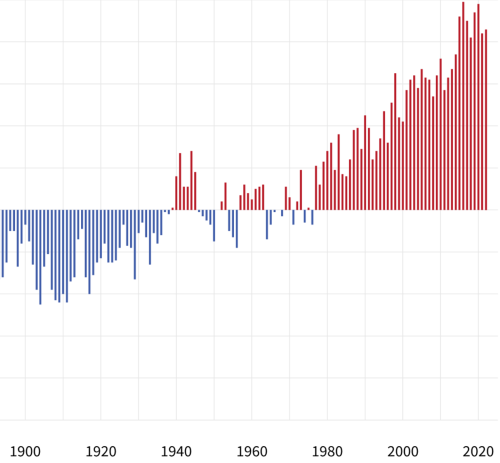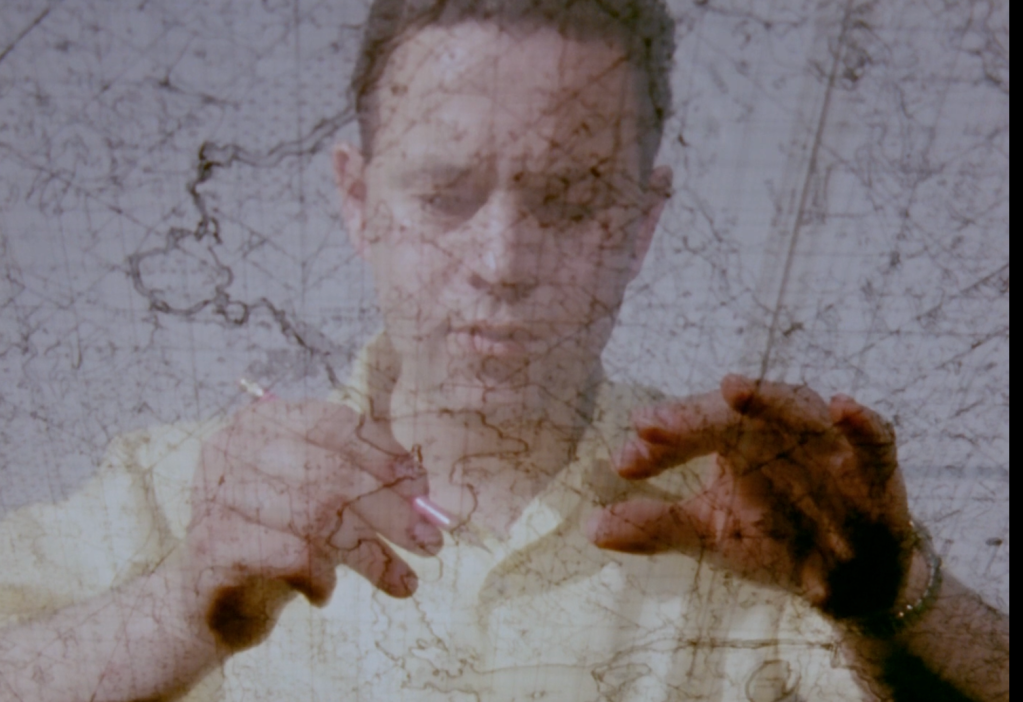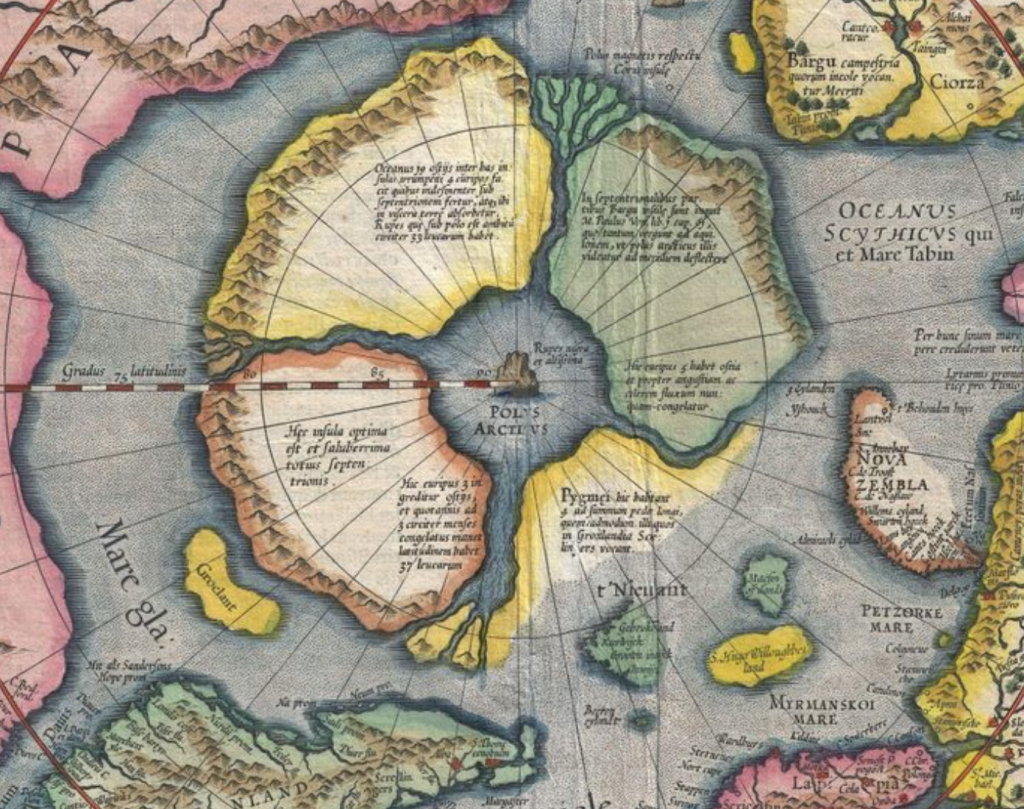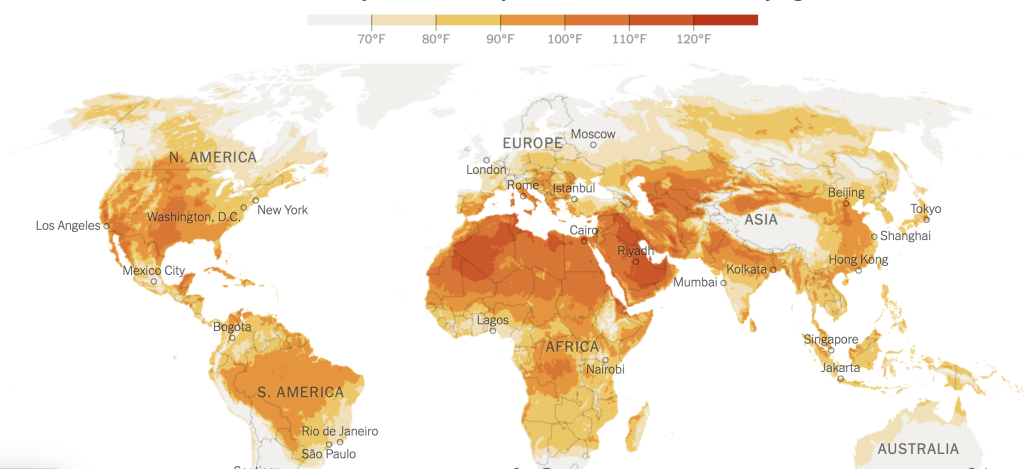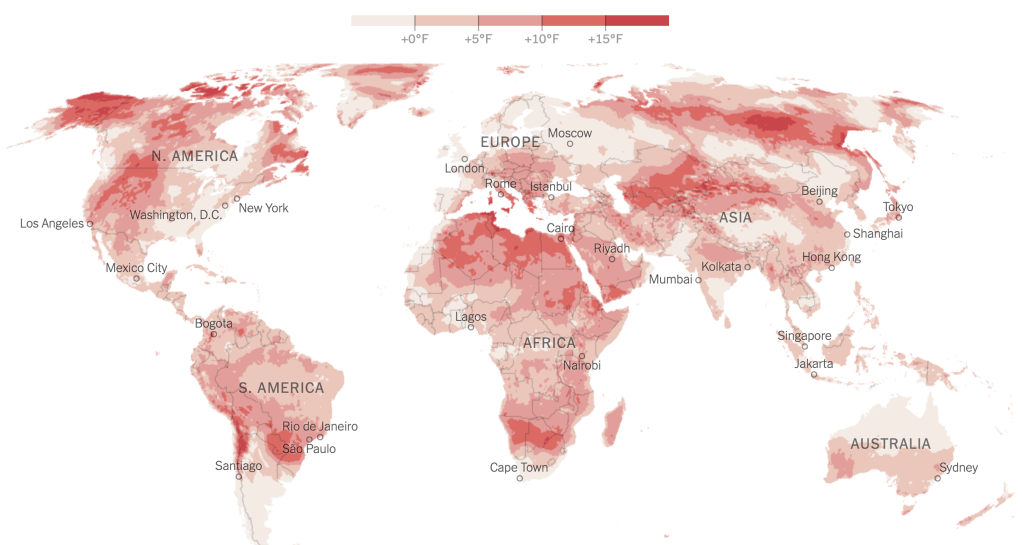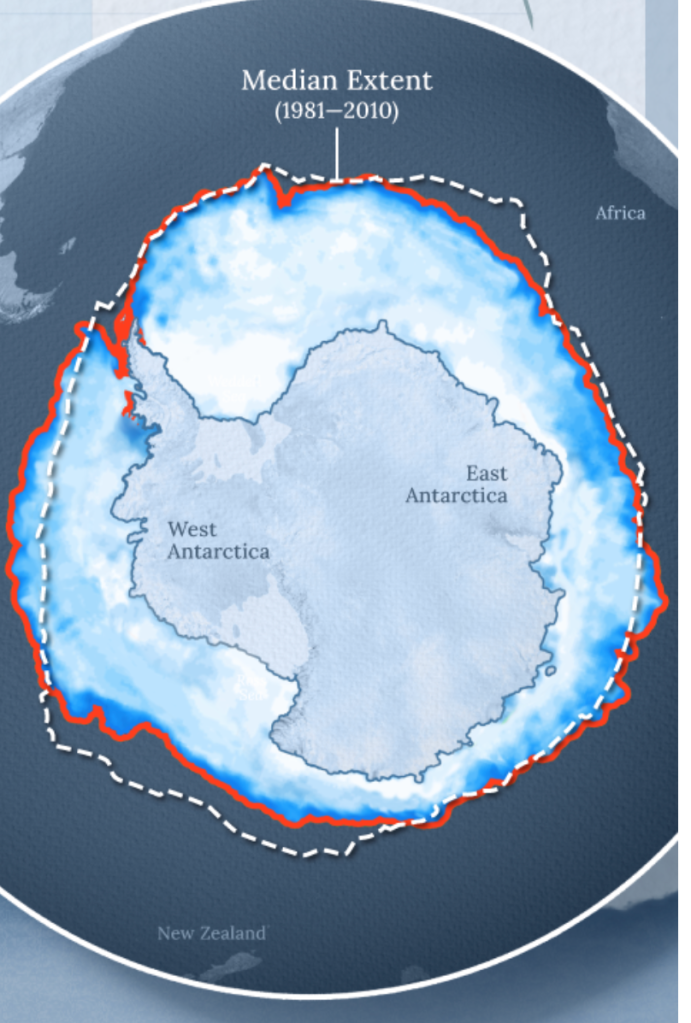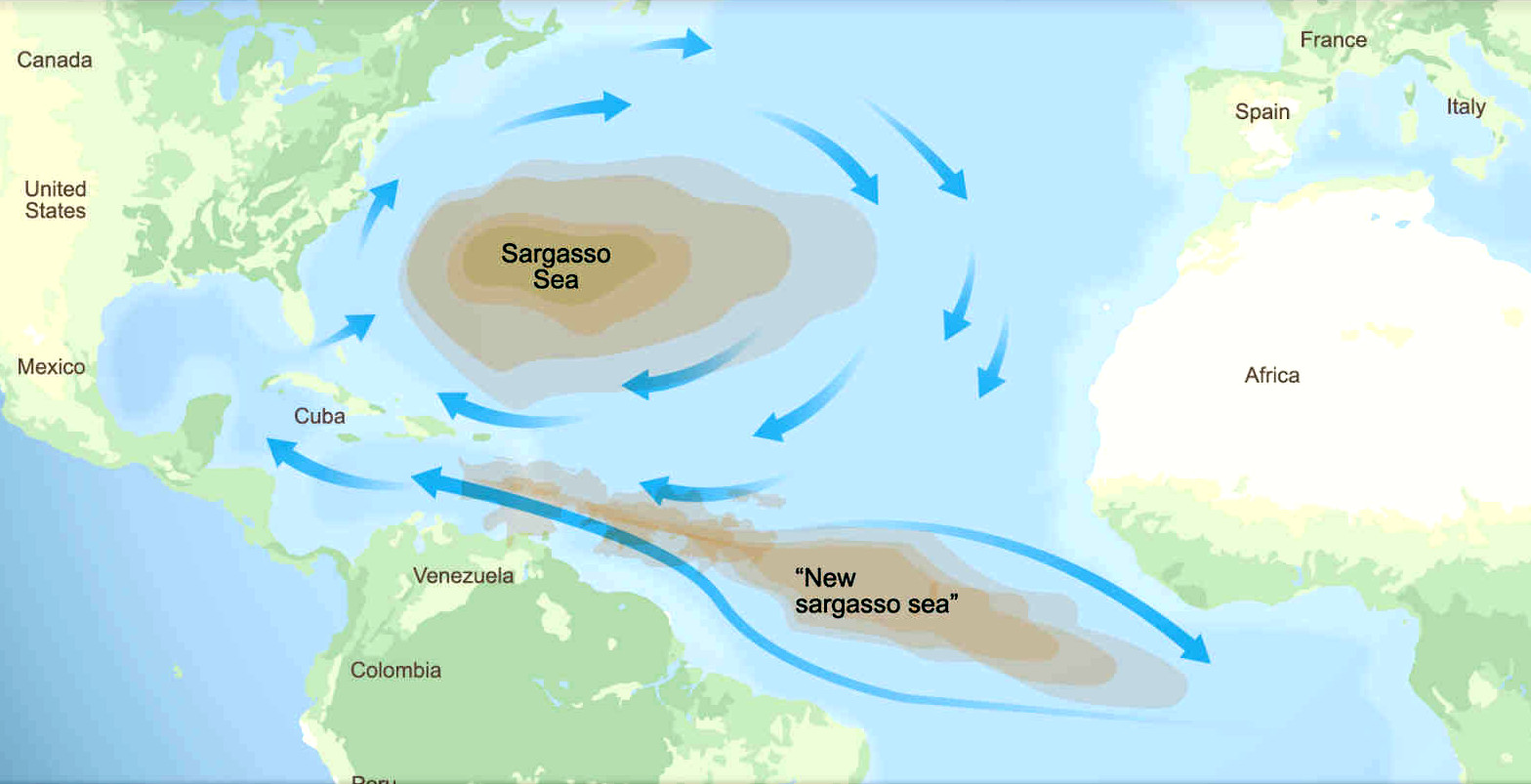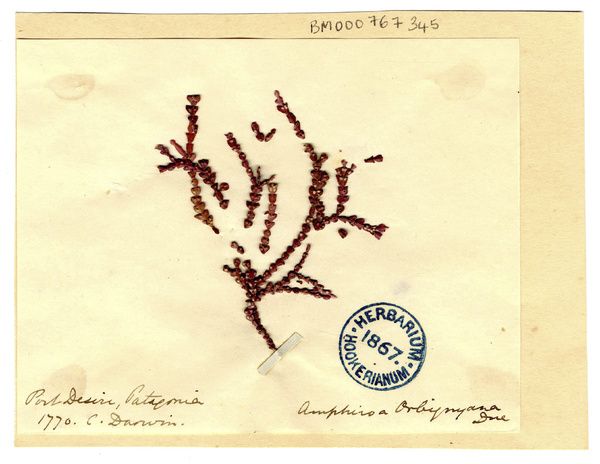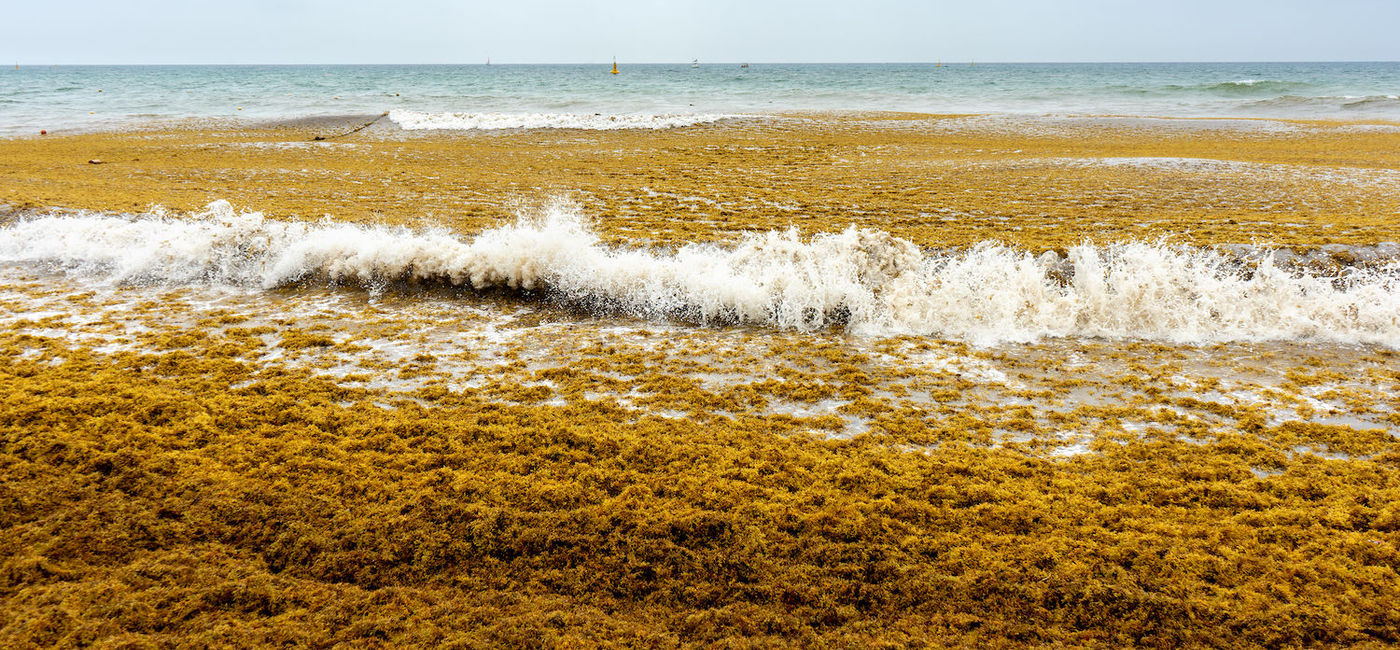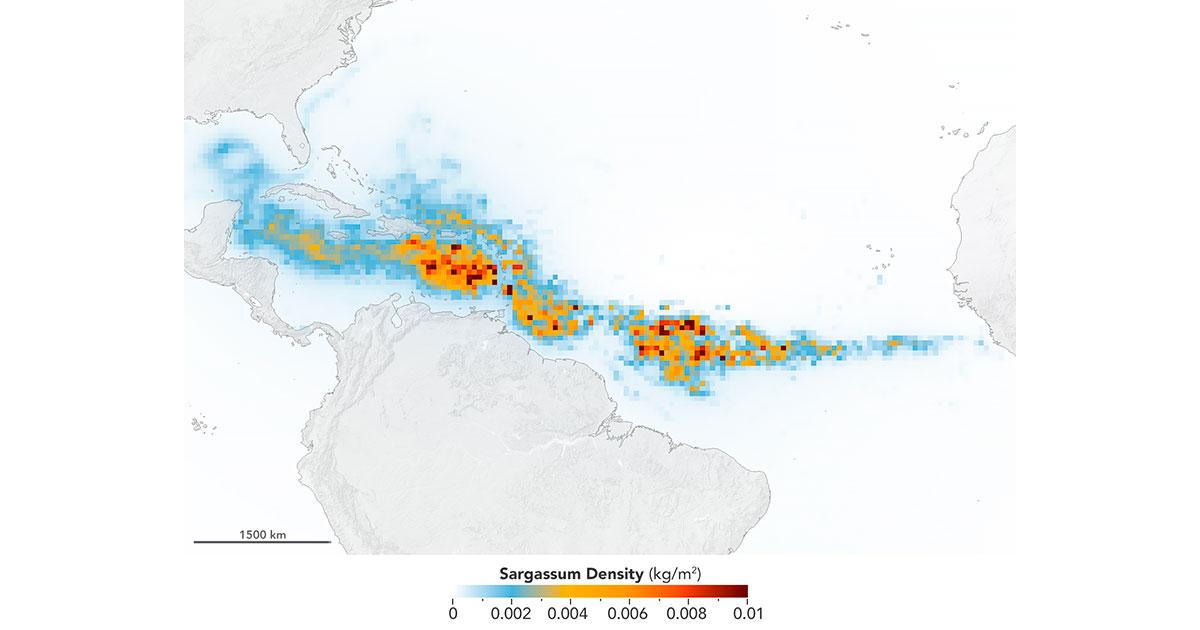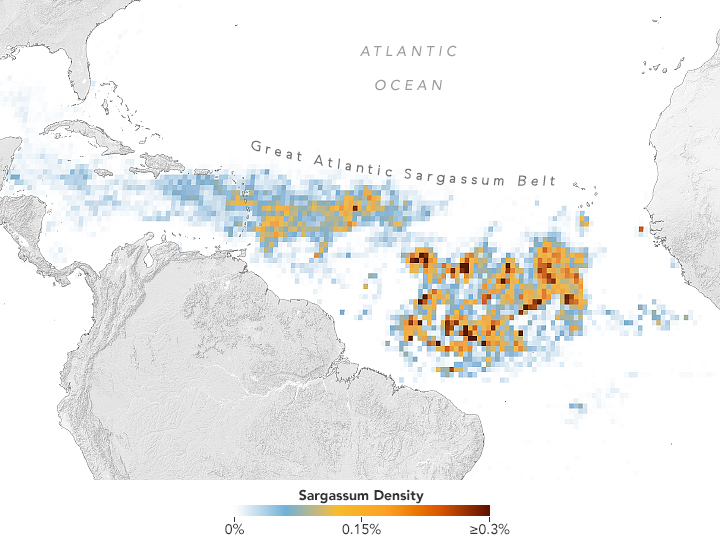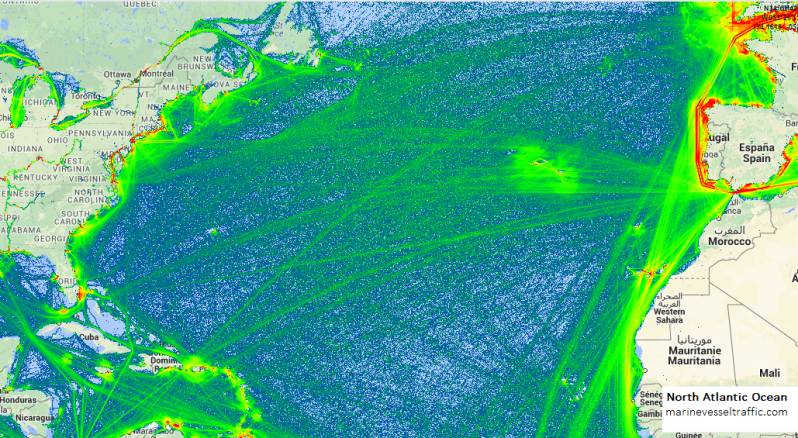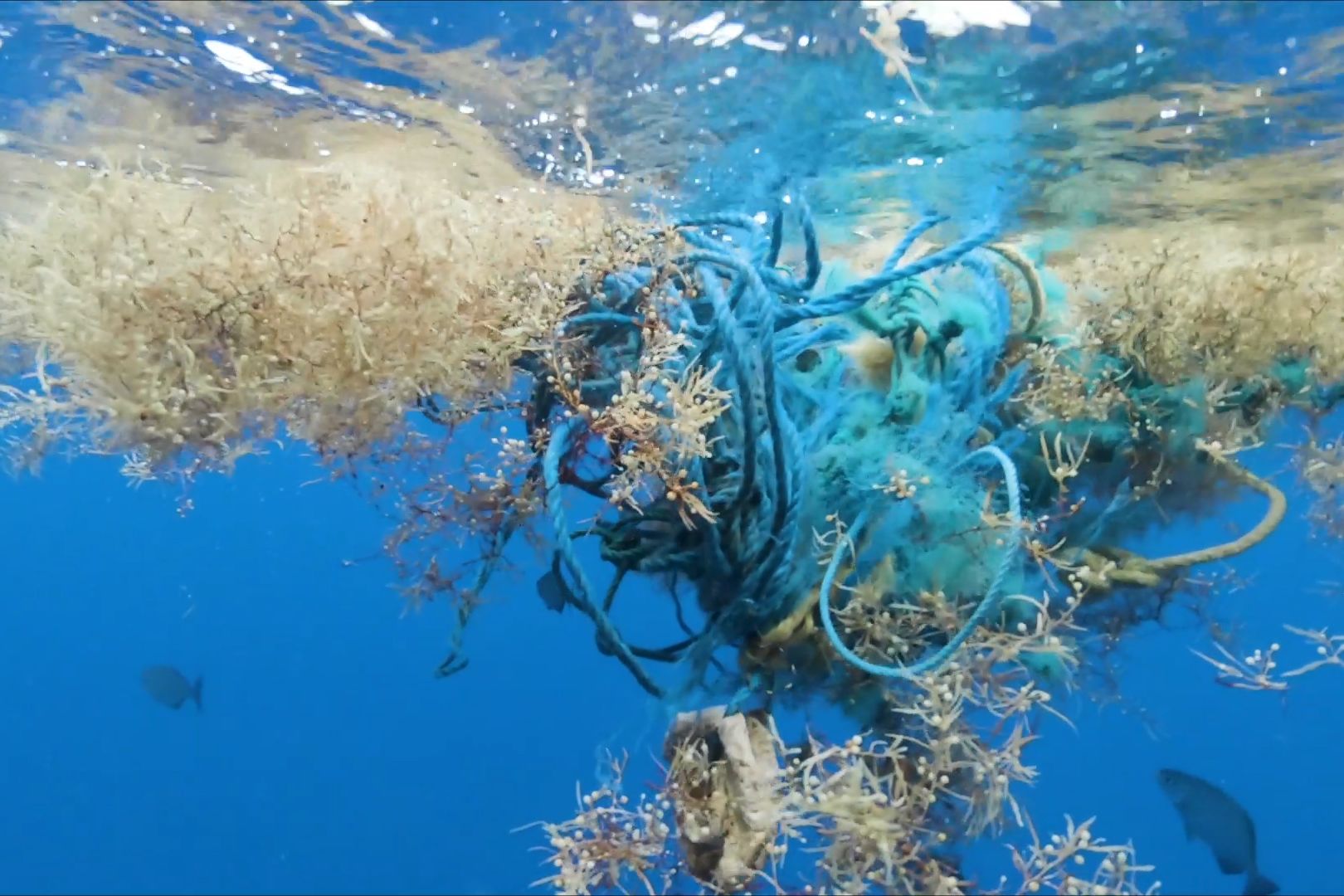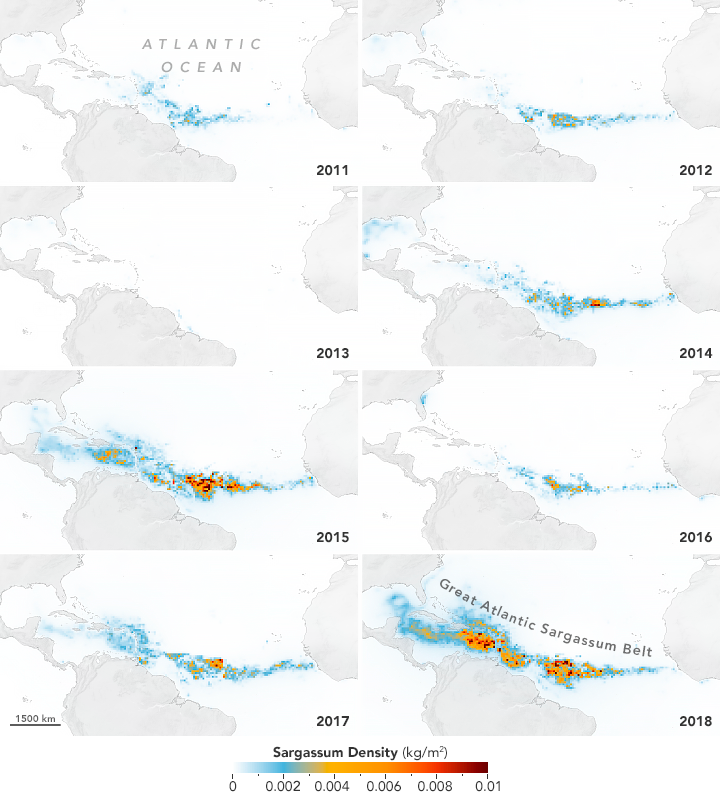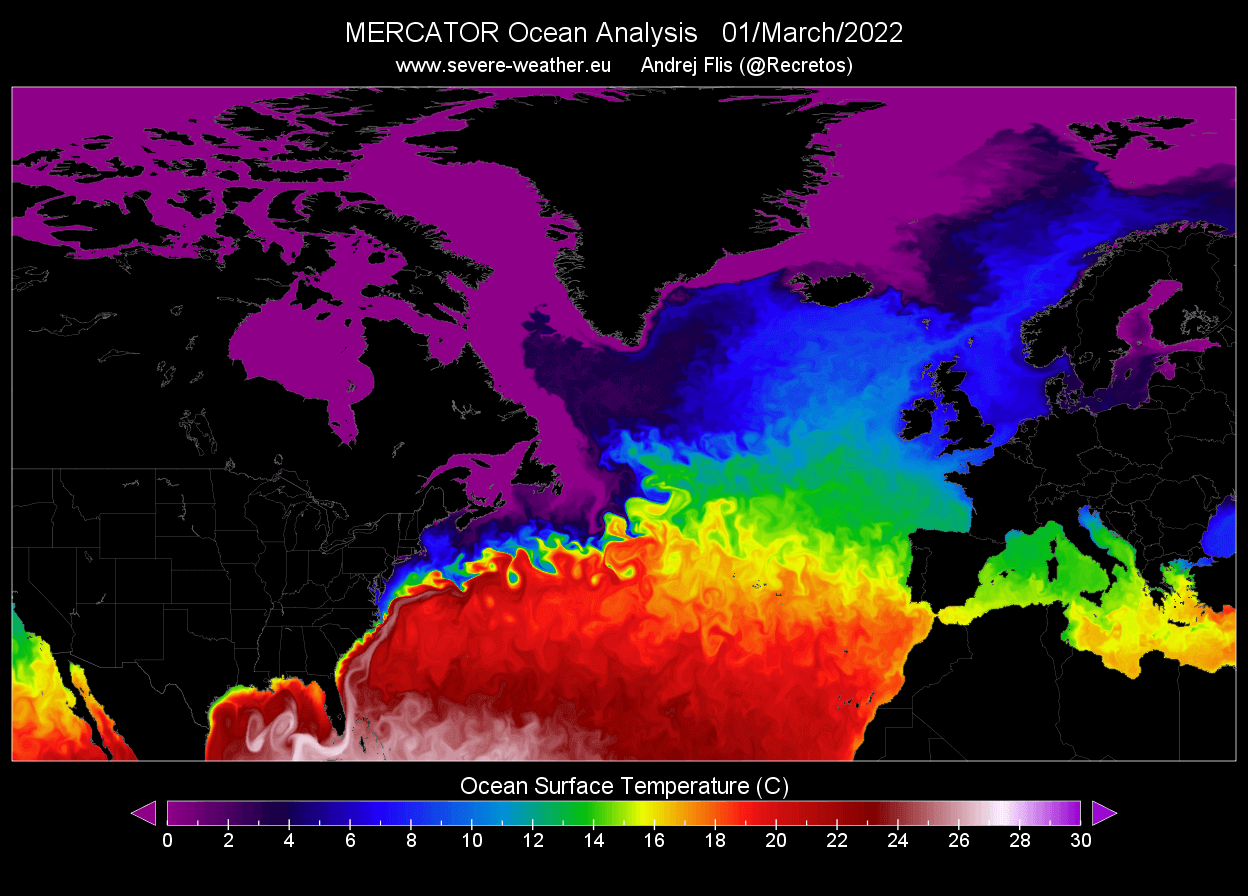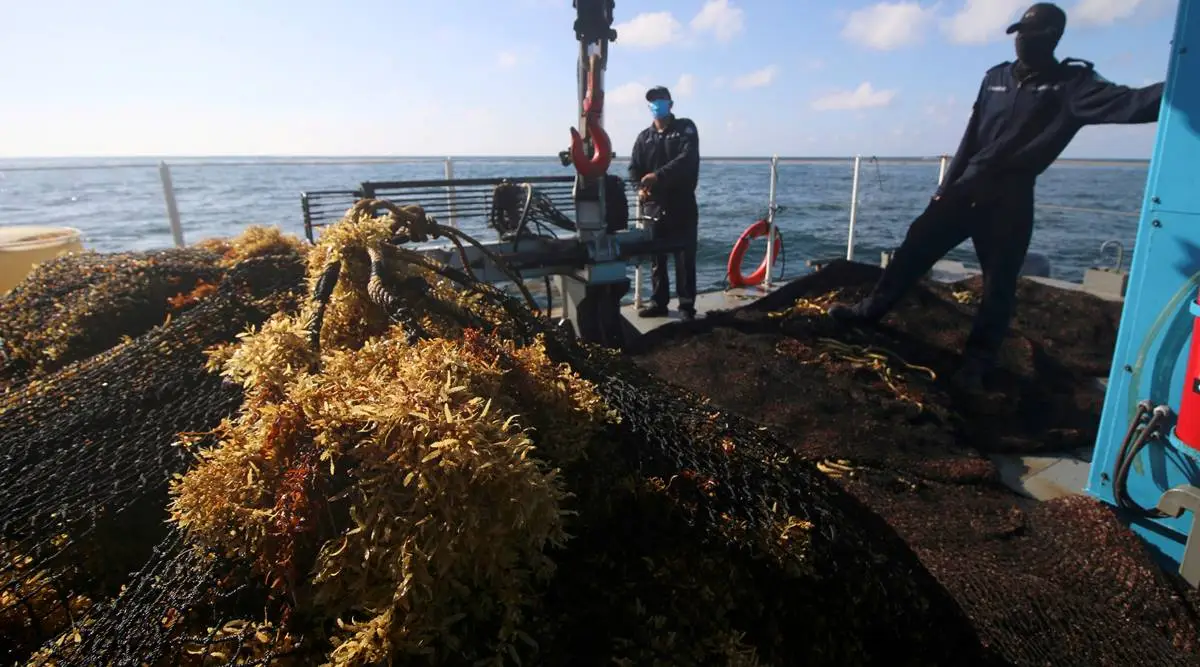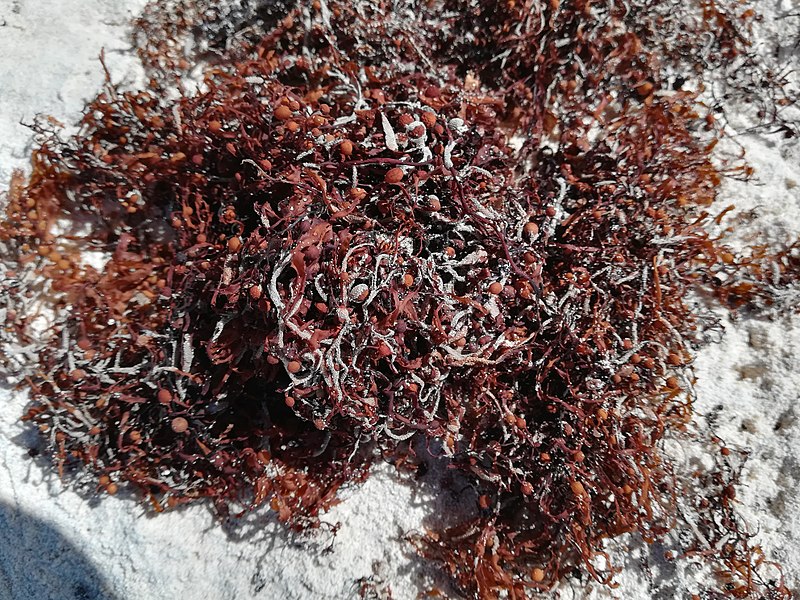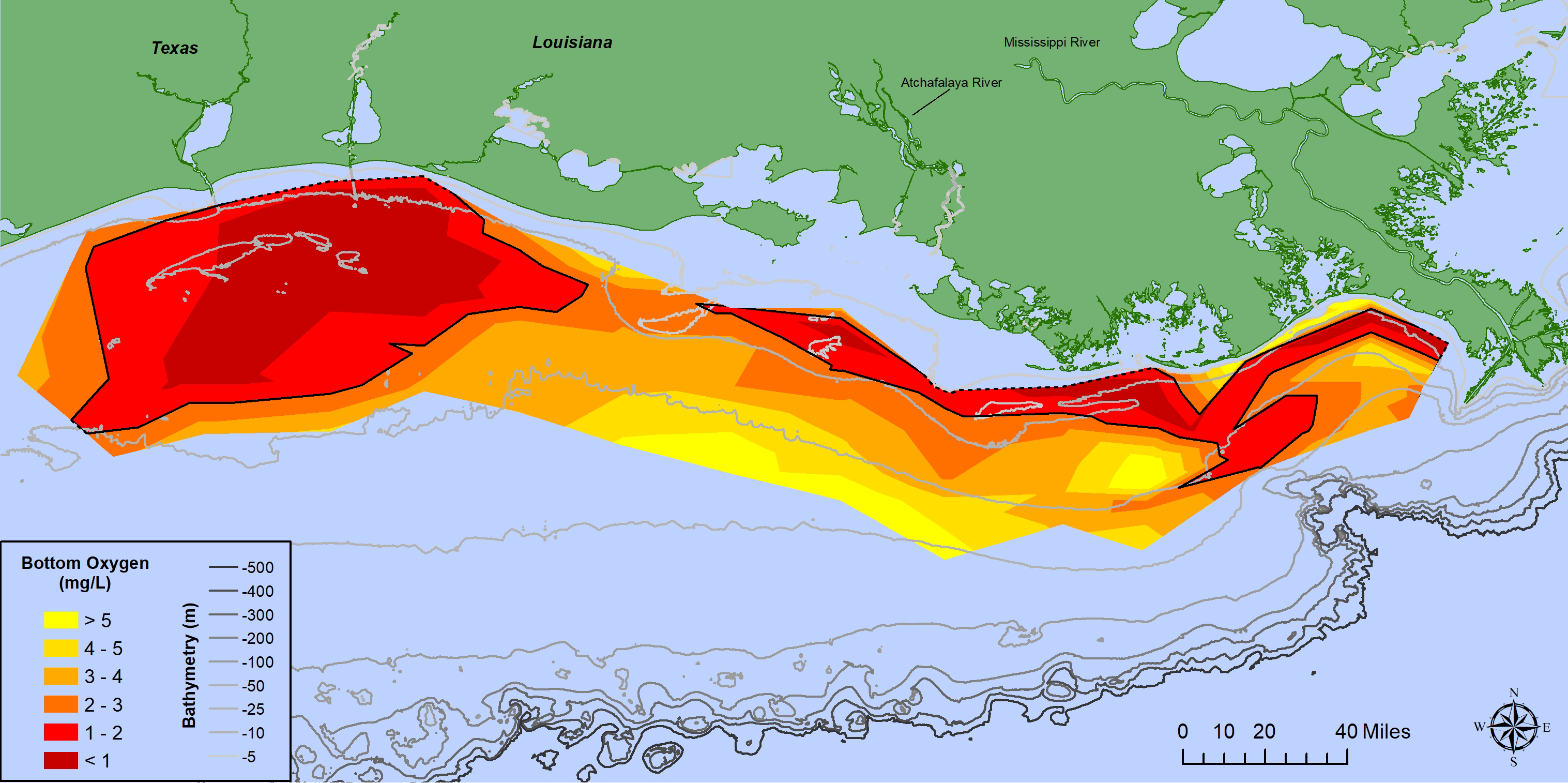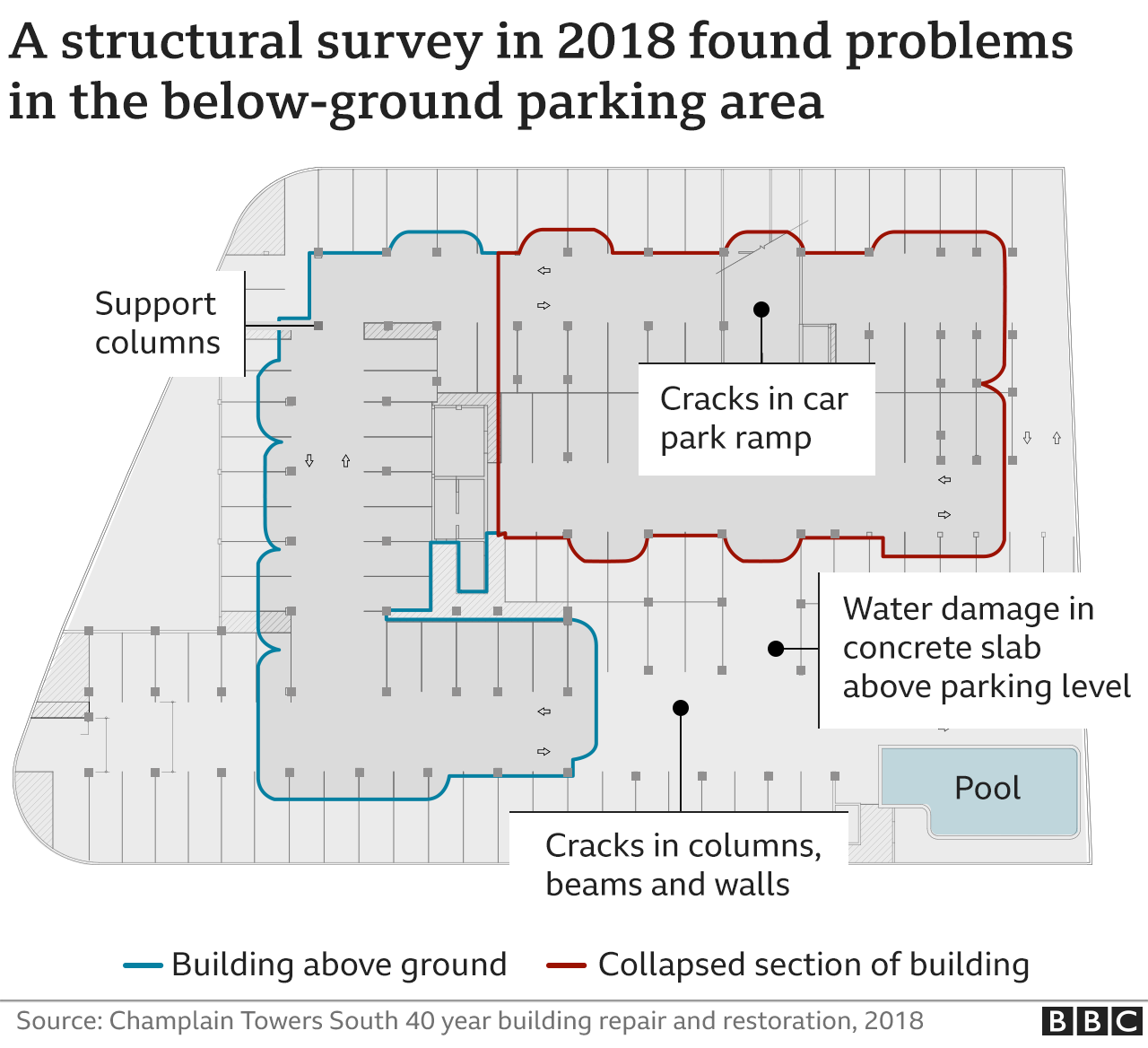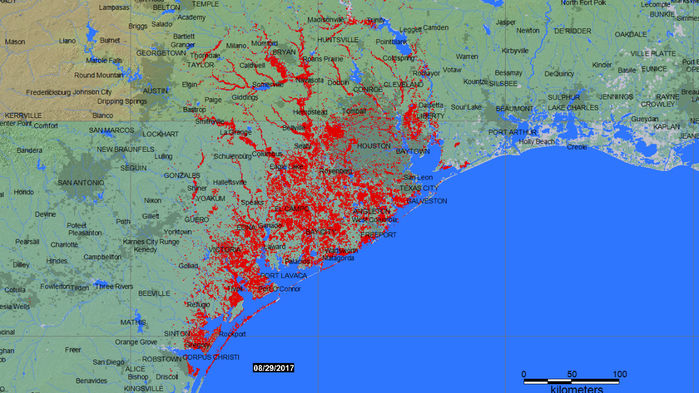With global ocean surface temperatures shot way off the charts by mid-March, beyond forty years satellites have monitored sea surface temperatures, we’ve been struggling valiantly to map the changes in sea-surface temperatures, both globally and locally, in satisfactory and meaningful ways. The disruption poised to cascade across the planet in what might be the summer able to make climate change a less contentious issue of politics or partisan polarization. Maps of the remote sensing of surface temperature–sea surface temperature in specific–are shocking as they broker even deeper forms of estrangement, rendering the global temperatures against a baseline of the postwar period. The accumulated data from the first era of remote earth observation by satellite has generated a terrifying picture about which we lack a storyline, or a way to narrate our own relation. The problems of a metageography of impending global collapse that lacks any narrative resolution, more properly, and compels us to attend more closely to the conventions and imagery of how we map sea surfaces to interrogate more closely what we are actually seeing in such maps.
The totality of global warming are nowhere more evident than in the charts of sea-surface anomalies of temperatures, which pool red and orange on the planisphere in unearthly ways, but the correlation of remotely observed temperatures that deviate with standards of a century ago that showed foxing or burning over a decade ago, as the “hotspots” of intense rising temperatures near Greelnaldn, in Hudson’s bay, or off the coast of Maine and Siberia in July 2009 or even more strongly in September, 2011–but demand us to investigate the changing relation of land and sea.
July 2009/ NASA Earth Observatory
September, 2011/NASA Earth Observatory
–that have reached such record levels to lead Earth Observatory scientists to describe long-term effects of global warming by diagnosing that the global ocean “has a fever,” with disparities from past averages above three degrees C, not a lexicon of hyperbole, but suggest the inevitability of what early modern physicians would call fast approaching critical days–the discrimination of the moment when the patient will become “critically ill” or persevere, but that challenge us to classify the nature of such critical onset, as the ancient physician Galen felt fevers turn to more severe or worse forms at measurable moments, registering the temporal progression of fevers in his case histories that form the basis for modern clinical records to classify the effects of the fever in its ‘quotidian’, ‘tertian’ or ‘quartan’ stage. But we sadly seem to lack the same sophistication for record-keeping of global warming, in the age of the Anthropocene. If Galen distinguished fevers by the responses they required from physicians between those that were acute (‘fast’, oxys, or celer) and chronic (‘slow’, chronios, tardus), the action of this oceanic fever requires is particularly acute.
Although Galen suggested that the “best physician” would take care to distinguish and discriminate the causes understanding the imbalances of vital humors that he argued caused illness, the causes that underlie such entirely anthropogenic rises in ocean heat have been increasingly debated and even suppressed, even if there is more than adequate indications that the consumption of energy and burning of extractive fuels have creat4ed and exacerbated temperature anomalies–and little interruption has occurred in the increased extraction of oil and gas under the optimistic slogan of “energy independence”–not actually providing or producing sufficient energy for a nation but exporting more fuels than one imports.
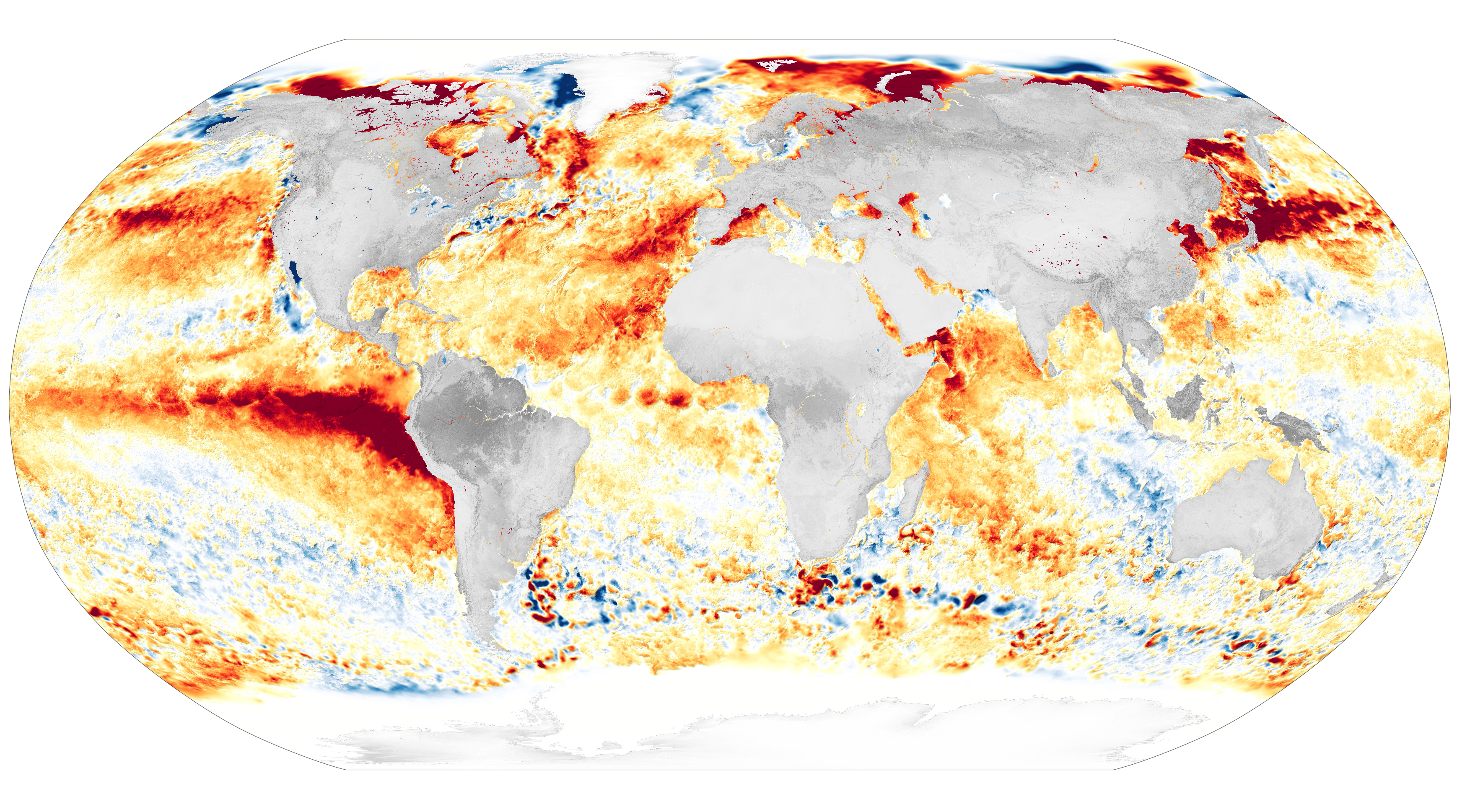
August 21, 2023/NASA Earth Observatory
The startling results of remote earth and sea observation stands as an odd counterpart to the iconic “blue marble” that became such a slogan of aspirations to global environmentalism almost a full half century ago. Yet the layers of these mapping tools seem, as the rage for composite forms of IKEA furniture, that arrives in assemblage components, to suggest a readymade far from Marcel Duchamp, as if to respond to the magnification of an imagined “migration crisis” by which the nation is challenged. If that crisis may be in fact false, or imaginary, even if migration rates have changed, and most migrants have arrived in the United States for work. The assemblage of the Border Wall is an elision of the identities and the experiences of migrants themselves, or the routes they travel or their work and trades.

IKEA Börder Wåll (2017)
The layers of our environmental maps of ocean temperature anomalies carry ideological presuppositions leaving us purblind to the massive scale of ecological changes in the global ocean, or ability to steer the results of global warming and planetary change by better grasping its effects, rather than creating indelible images of fear. As the practicalities of building a “Border Wall” with the cheapness Candidate Trump had promised, the proposal to create a readymade Börder Wåll that was a far more affordable option at less than $10 million–exactly $9,999,999,999.99 with a five-year guarantee–used the iconic instructions of the Swedish furniture company to imagine a version able to be assembled by screws and Allen wrenches whose pressboard standing a full ten meters tall. If the more affordable assemblage of the border wall was a potent figure for the political emergence of a salesman with little to offer the nation save the image of security, the layers of the remotely sensed map offer a similarly terrifying othering of the global surface, as if the known world were suddenly at variance from the world that we knew, if not destabilizing the very blueness of the seas.
In the famous “Blue Marble” images taken by those aboard the final Apollo 17 to the moon in 1971, we recognize the continents bathed in a sea of bright blue–continents we recognize from the map, but now see, for the first time, a powerful map, lit by the sun before our eyes. The blue nature of the earth is its most overwhelming aspect, however, unlike a map, as if we can see the sea below sparse cloud cover against the Arabian Peninsula, the Indian Ocean visible from the polar ice cap, with the earth’s other continents for the first time ever: we recognize and identify Africa, Madagascar off its coast, and clouds swirling over the ocean, no nations in evidence. It is othered, but made more recognizable, defined more than by nations by the brilliantly illuminated azure of oceanic blue that seems for all practical purposes to dominate the world’s surface beneath clouds.
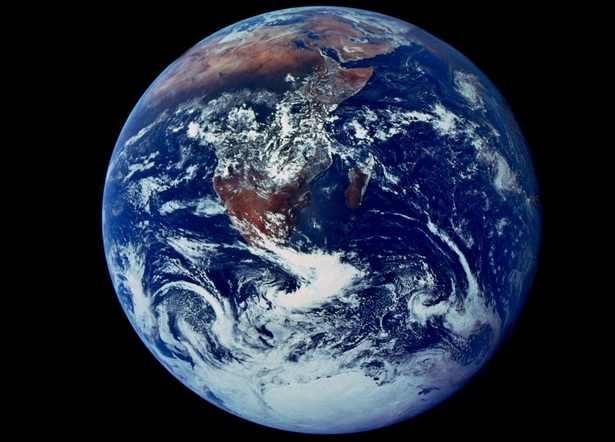
The icon of “Apollo’s Eye” soon the most reproduced in world history–an image of technological progress, but also a snapshot from space, taken off-hand at 20,000 miles per hour, a disappearing or receding planet, lit up by the sun, even thought the 70 mm camera on board was not intended for non-scientific ends, and the aweing nature of the film snaphsot was only recognized as it was develped by a film technician as a portrait of the planet. Although its authorship of who reached for one of the several Hasselblad’s not stowed away for more properly “scientific” purposes on the Moon in order to taken one of the great images of space tourism: one of the first remotely “sensed” images of the earth tilting toward the sun’s rays illuminates its blue oceans that are recognizable under swirls of cloud-cover, revealing recognizable continents–Africa; South Asia; Antarctica–from a perspective never before experienced. MODIS satellite reveal show the current oceans no longer as blue, but greenwith phytoplankton as oceans warm the acceleration anthropogenic carbons in the ocean, incubated by human-caused climate change or “planetary warming.” The Blue Marble now definitively receded so that it seems not a Hasselblad image but might be a photoshopped, the seas no longer offer an image of the Blue Marble. And nowhere is the alteration of sea-surfaces evident than in their temperatures, a gradient relatively new to GIS, but all too compelling if also problematic to render in convincing ways. Can we better render the layers of the warming ocean in ways that allow us to better come to terms with the effects of planetary warming?

Blue Marble Photograph by member of Apollo 17 Crew Commanded by Eugene A. Cernan
The Blue Marble image was widely reproduced in global newspapers. But it was only recognized as of interest soon after it was developed by a technician. What NASA called “AS17-148-2272” would be quickly adopted as the “Earth Day” flag. But if it was never definitively credited, and was only in a sense “discovered” by the technician who developed it, its appeal grew as it was consumed by an audience eager to imagine what the members of the space flight teams saw, and as they existed the Earth’s atmosphere. Its immediately recognizable emotive and inspirational power as an image of the earth’s totality as never seen grew, in part, because it was snapped as the winter solstice approached; the full illumination of planet Earth’s vibrant blue oceanic surface appealed as a moral centering, as it became a basis for the Earth Day Flag. Its recognizable nature was not only the crispness of its geographic outlining of continents as they lay and appeared on a terrestrial map,, but, unsurprisingly perhaps, as they echoed and modernized the very claims of divinity that early American environmentalist Henry David Thoreau found as he left Concord ‘s society and his daily job to contemplate the blue waters of Walden Pond he had praised as “cerulean” a hundred and twenty five years earlier, in a wor that was widely read by modern environmentalists in the 1950s and 1960s. The deep blue ocean surfaces from the polar cap of Antarctica to the Mediterranean, around the coast of the entire African continent and stretching to the Persian Gulf, was a counter-map to national maps of borders familiar from school maps, but asking we alter perceptions of the “blue marble” delicately suspended without strings as an image of strength and stability, without any, or at least apparently without any, technological mediation.
But the image of the blueness of those oceans is now undeniably an image that has receded in space, not an eternal image of timelessness, and transcendence, but a definitively receding past, as satellite observations of unprecedented oceanographic detail and range that allowed high-quality ocean color data by the MODIS-Aqua satellite systems announce an inevitably greening of the surfaces of the global ocean. The blue marble icon i, confined to the past, and an artifact of the past, after the anthropogenic alterations of phosphorus and carbons in the global ocean has, in an era of anthropogenic global warming, so boosted phytoplankton populations to recolor the ocean. The new surface ecosystem indicate new variety of microscopic organisms photosynthesizing in the global ocean, and carbon-enriched phytoplankton populations whose abundance in global oceans have “turned the seas green” and “othered” the ocean that was once such a pristine blue.
The iconic call to environmental consciousness map of the blue-drenched seas taken 28,000 miles from Earth at a point where the manned spacecraft crossed the point an Earth fully illuminated by the sun is definitively of the past. Eugene A. Cernan, the commander of the last manned lunar mission who claimed to have taken the photograph claimed to capture the crew’s collective astonishment at the spaceship’s transit before the sun. But he has returned multiple times to the sense of deep surprise by which undoubtedly melancholy window-gazing brought a sudden defamiliarization of earth and disorientation of the observer as much as a feeling of transcendence. It was removed from technology, but made him the most privileged observer of earth with a clarity and simplicity that had in fact been never experienced in history. The placement of himself was as strongly resonant as the fleeting nature of the perspecive, and “Do you know where you are at this point in time and space, and in reality and in existence, when you can look out the window and you’re looking at the most beautiful star in the heavens — the most beautiful because it’s the one we understand and we know, it’s home, it’s people, family, loved, life — and besides that it is beautiful?” The stunning image comprehending oceans and continents with “no strings holding it up,” “in a blackness that is almost beyond conception” in a soothing defamiliarization of awe.
The “blue marble” immediately hat was reproduced globally in print newspapers was an icon of globalism and an image of transcendence before it was an icon of environmentalist Earth Day that would spur a new consciousness of those blue waters’ preciousness and purity by showing them as if they were indeed Walden Pond. The photograph registered an oceanic expanse that appears timeless, and so intensely blue, a pocket of living life that might be modern version of Henry David Thoreau’s praise of the transcendent vitality of Walden Pond’s “cerulean” blues that reflected the sky so intensely as a mirror. (Let’s dwell a bit on this comparison: if Thoreau described the pond as “the landscape’s most beautiful and expressive feature” as “earth’s eye,” “looking into which one the beholder measures his one nature,” and his most prized companion during in “this mode of life” away from Concord, as he grew “suddenly sensible” of a sufficient space nature afforded, we are filled with dread at maps of rising surface temperatures that seem to bode an end to seasonality.) The awe the Apollo 17 Commander Eugene Cernan claimed to be compelled to snap the first image of the earth’s surface, entirely illuminated by the sun’s rays from Apollo 17, the south pole tilted sunward before the winter solstice and oceans illuminated as a seat of life seem a modern updating of Henry David Thoreau’s sensation of being in a privileged site of contact with the divine at Walden Pond. (Cernan’s claim was contested, but he felt the image akin to a re-centering of self.)
The Apollonian view that was communicated globally became an icon of technological progress and of re-familiarization of the earth. This was so much so was this the cast that the image that was reproduced globally with an unprecedented rapidity–a signe of the new globalization of the news–became adopted as an icon of the ecological movement of the first Earth Day, first observed two years previous in 1970, as if to acknowledge how the photograph taken by Cernan or another of his crew effected a changed relation to global space. In sharp contrast, the planispheric image of the increases in global temperatures is a deep dread, provoking an absence of orientation or storyline: dread is the only word for viewers’ disorientation before maps of rising surface temperatures that reveal the disparity of recent global temperatures from the recent past. Is it any coincidence that the seaborne Sargassum proliferated in the mid-Atlantic in record-setting ambient ocean water?

They bode an end not only to seasonality, but the vitality of the global oceans–if not the vitality of the habited world itself. Nowhere is this more apparent than the slick of petroleum that have appeared at the great site of marine diversity and vitality–the Gulf of Mexico–that has become a hub of the offloading of global oil supplies to the Americas for processing, seen as a “chokehold” for daily maritime oil transport of the 56.5 million barrels that traveled on maritime routes–about 63% of world’s total oil production. Indeed, the critical maritime routes for the global transit of oil were long referred to as “chokepoints”–

U.S. Energy Administration, based on 2013 data of Lloyd’s Intelligence, Panama Canal Authority, Suez Canal Authority
The registering of land temperatures monitored from satellites at a closer distance has created far more terrifying images of defamiliarization this summer and in recent years. The temperatures anomalies is hard to recognize as anything like a map that we might easily recognize, and indeed push the boundaries between cartography and art. If all art may be about estrangement–ostranenie for Russian formalist literary critic Victor Shklovsky and his circle–or “defamiliarization” of the known, the estrangement of global warming temperatures area shocker and an artistic narrative we do not know what to make of save as a learning model for the entrance into the new era of the Anthropocene.
If the politics of estrangement was for Shklovsky rooted in a new sense of life become art, and a revolutionary estrangement of self, global warming seems the utmost in estrangement, although what living through global warming honestly remains hard to come to terms or conceive. It is, for one, outside of our familiar narratives, save the apocalyptic, and we may tend to the apocalyptic as a result. But, this post will suggest, the danger is in a sense deeper than a failure of narrative alone and in ways that we may take a clue from the Russian formalists themselves to understand: for the formal presuppositions of visualizing and of mapping sea temperatures as continuous with land, and as able to be mapped in the same terms as the anomalies of land temperatures, is an ideologic construct and choice, independent of the content of the global maps of raising temperature: for we flatten the sea temperatures at our own risk. Flattening the ocean expanse as if it were akin to land temperatures ignores the extent to which greater heat that drive increasing global temperatures have been storied within the ocean, and the risks of rapidly cascading nature of changes in ocean temperatures that anthropogenic change has produced.
Indeed, the critical ways that mapping sea surface temperatures and mapping ocean resuources as if they were sites for extraction, akin to land-extraction, has led to an increased dependence and sanctioning of offshore waters for extractive drilling, as nations from Canada to Russia to the United States to Argentina to Mexico aim to expropriate underground reserves of oil to boost their national economies and trade, auctioning off lots to the highest bidde, or subsidizing offshore drilling of gas and oil. These huge anthropogenic changee masked or concealed by relying on the relatively surperficial maps of remote satellite sensing of sea surface temperatures alone.
By the middle of June, the GIS anomalies of global temperatures from a baseline of my pre-college years revealed how much personal history had intersected with a radical change in global climate. One’s life memories somewhat incredibly and suddenly in synch with global epochs, reminding me of how very unlike global temperatures for most were compared to the normal in my own memory as well as that of the planet–a daunting prospect and possibility indeed to get one’s mind around. (It’s hard, however, not to wince at the echo of the fractured partisan topography in this map of global temperature change, even if the confine of blue to the arctic regions and western and northeastern United States ; the carmine warming temperatures looming over Canada is quite hard to dissociate from the dry forests that ignited in fires across so much of the nation this summer.)
The view from a generation–if not a life perspective–showed a modeled planisphere hard to get one’s mind around, scorched by temperature anomalies, from the ocean off of South America, the arc under the Aleutian Islands, the hot-spot off of west Africa and burn holes of Europe and Siberia. The warming of the global atmosphere was long seen as “one of the most pressing problems of the twenty-first century,” the global maps of heightened atmospheric warming due to elevated carbon levels now a full 50% above preindustrial levels–and larger than ever seen on earth since three to five million years ago–according to paleoclimatic data–make it hard to place the climate changes amplified by greater methane, nitrous oxide, and fluorinated gases. It is a register of the all too human art to burn carbon, if not just a deeply depressing image leaves one drained of any agency; it is hard to stand before it with anything like the exultant transcendence of fifty years previous.
As carbon levels continue to crest above 420 ppm, we look back at the high levels of CO2 fifty million years ago, average temperatures reached about 10°C warmer than today and the planet ice-free, with sea-levels lapping shores two hundred feet higher above current sea-level. One can segment it many ways, but the huge escalation of temperatures of the oceans–which have stored a vast amount the growing heat we experience on earth, or a whopping 93%–moves unlike how heat is experienced in land, but reflects the most densely populated coasts–and densest sites of anthropogenic waste–

–in the global ocean.
The warming of seas were long recognized just several years ago–in relation to a dataset from the twentieth century and first two decades of the twenty-first–in ways that call attention to just how much atmospheric heat the global ocean has absorbed into its own waters in the past century–and how much more it has additionally absorbed, perhaps putting it over the top as a site able to sustain life, in recent years. If death was the “master fear” that philosophy was able to conquer for stoic philosophers from Seneca to later Romans, able to be overcome to conquer fear itself, the increasingly inhospitable global oceans suggest little to meditate upon we have an ability to process save their own evanescence as habitat for life: the images are perhaps not records of a life lived, but are literally the collective residues of “lives lived” in the twentieth and twenty-first centuries. There is no known script of how to live that they offer for virtue or nobility.
We are increasingly pessimistic about our world view, and the maps of global warming fit with an increasingly pessimistic world view that has been seen as a problem of global purpose, at least from the US-led invasion of Iraq in 2003 without debate that after eight years of conflict saw “shock and awe” lead to wide questioning if it was worth fighting. If the 3.4 million aircraft sorties that dropped the equivalent of 640 Hiroshima bombs in Cambodia and Laos had cast a shadow over America’s global purpose for one generations, the burning of 700 out of control oil field fires lit by retreating Iraqi forces as they withdrew from Kuwait under fire: as U.S. and allied troops arrived to defend the fields in a war of a hundred hours, of bombing sorties of air-launched cruise missiles, Iraqis lit wells as they retreated to blanket the air rendered unbreathable for soldiers without gas masks in improvised smoke screens of toxic with particulate matter. As “allied” intervention destroyed an amazing 3,000 tanks and 1,400 armed personnel carriers in a matter of days, with countless other vehicles, the plumes of 700 gushing wells were lit, creating up to 300 oil lakes in the desert whose pollution of the soil is as deep as four meters today, now hardened to sludge leaving lakes that are toxic today, even as almost two and a half million cubic meters of sand were cleared. Concservationists remained concerned about continued effects on humans and the environment.


The very commodity over which the war was fought became an aggressive act for the military advantage, squandering petroleum resources the west valued in an age of ecological aggression the transformed the Greater Burgan oil fields into an anthropogenic inferno. Wells were commandeered in a scorched earth policy of unprecedented scale, an environmental disaster that cost over a billion to extinguish, individual wells only able to be extinguished at a rate of one or two a day, as forces were anticipating billions to reconstruct the fields the United States led “allied” forces to defend. The anthropogenic effects may be obscured by of the sovereignty of Empire, far beyond the bounds of the nation state, and the bounds of the Kuwaiti oil fields.
If the logic of direct intervention in the 100 hour war depended on the myth of effective global military apparatus ready to wage a “just” war, asserting military control over Iraqi and Kuwaiti oil fields in the logic of war, the lighting of oil rigs and gas rigs by retreating troop and bombs improvised a network of resistance, blanketing the region with smoke that made aerial surveillance impossible and useless, and offered deep health risks to those troops with “boots on the ground.” As wells burned they ignited the very source of one of the sources of shipments of crude to be refined in the Gulf of Mexico, where much global petroleum is offloaded. The arrival of petroleum in the Gulf’s dispersed system of refineries and multinational companies was a basis for the extension of “American interests” to a region in the Gulf seen as so critical to the globally extended economy to justify the “just war” by American-led forces. The global web of oil refineries across the coastal region was a way in which the wealth of the United States was preserved and transportation economy fed. If oil spills had declined in recent years in U.S. marine waters, the offloading of forign oil in a network of refineries established in American waters in a site of deepewater oil and gas production was a basis for the extension of American “sovereignty” that had ignored the anthropogenic effects of oil toxins was released in the war, if far beyond the US coasts.
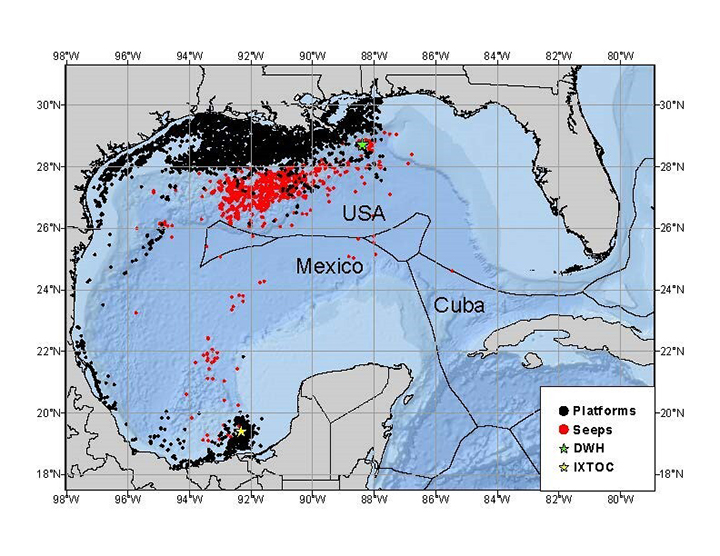
If America was stunned that the United States had coordinated the Iraqi invasion of the oilfields in Kuwait, the new source of most oil refined by American oil companies on shore, the war that was fundamentally about blurred borders, and control over the continued flow of extracted petroleum and gas for commodities, the burning oil fields took back the very grounds of production by lighting the oil rigs as torches in the night.
“Kuwait Oil Spill, 1991” by Christopher Gomez (2016)
The anthropogenic scars of the 1991 war with Iraq created warnings of a nuclear winter never to materialize in 1991, burning of hundreds of thousands of barrels released one and a half billion barrels of crude into the environment including “oil lakes” burning for months created but 2% of global emissions. A further hundreds of thousands of barrels of oil from oil field rigs gushed through most of 1991–a record of anthropogenic harm predating Paul Crutzen’s popularization of the concept of a geological epoch distinguishable by its environmental archeology. While the Anthropocene is dated as most evident from the 1950s, as the acceleration of technologies and explosion of atomic bombs left new residues on mountainsides and the planet, the invasion came at the end of the Cold War, at a time when the mobility of troops across the planet had grown in a converse of globalization. The ability to move troops to “invade” or “free” Kuwaiti oil field by aerial bombardment, that mobilized thirty one nation alliance against “military targets” by B-52 strikes and hellfire missiles to prevent Iraq from occupying the oil reserves on which America depended was called a “just war,” but the intervention led to the combustion of eight hundred oil well rigs, three quarters catching fire and burning, and fifty gushing oil onto the ground, until they were capped in October 1991.
The drive to protect oil and gas led to oil fires burning, releasing about 355,000 tons of crude. Their destruction was a retaliation of the sovereign control of speedy troop movements in an intervention that paradigmatically revealed a new sense of Empire asserting sovereign control over Kuwaiti oil fields in a self-defined “just war.” It became a monument of anthropogenic alteration of the landscape by an environmental disaster of new proportions and scale. If the term “boots on the ground” only gained currency in the Invasion of Kuwait, the term that dates in the military from the hostage crisis in Iran suggests the limits and frustration of global mobility, but conceals how the grounds of the region were altered in decisive ways, responding to how the United States showed its readiness to move anywhere in the world with a massive show of force of unprecedented scale, in a new multi-national effort difficult to map or narrate as a story of “boots on the ground,” or to register in the consequences of how multi-national forces intervened in oil fields in Desert Storm.

Operation Desert Storm/U.S. Aarmy
The burning of wells by retreating Iraqi troops left a residue left across the desert sands. Accumulated soot from petroleum refineries and carbon–“tarcrete”–spread as a residue of the war; the dark plumes continued to spew400 metric tons of particulate matter of 2.5μm daily from oil wells with over a hundred million cubic meters of natural gas; sixty to eight million barrels of oil directly entered the Gulf in a major environmental disaster that affected the entire ecosystem, as at least fifty oil wells gushed to the ground and eight hundred were destroyed with explosives, if the total carbon emissions were 2-3% of the global annual anthropogenic burning of fossil fuels and but 0.1% of global CO2 emissions. The local density of soot in the Arabian peninsula lowered climate temperatures by 10 degrees C, and covered extensive areas in Kuwait, Northern Saudi Arabia and the Gulf. Gushing wells flooded the oil fields with lakes of petroleum of up to ten hectares, polluting the Gulf, nearly fifteen thousand million cubic meters of oil leaching in Burgan alone–a site of major air attacks–and 22.5 thousand million in total, much from the armored tanks an munitions were abandoned by soldiers in the desert.
Air Attacks and Major Clashes where Depleted Uranium Rounds Fired into Kuwaiti Oilfields
If the 1991 invasion was a critical starting point in staging a deep environmental estrangement than the rise of the new form of military intervention Negri and Hardt argued epitomized the global interventions for just wars in the new legal formation of Empire. The aggressive American-led military intervention ostensibly to “maintain peace and order” by ensuring the smooth circulation of petroleum extraction from the oil fields of Kuwait and Iraq that were the true targets of western desire. But was the burning of oil wells on the border of Iraq not an active rejection of the claims of this new formation of Empire to the Kuwaiti oil fields? Before a feared economic disintegration of multinational claims, the military intervention and conquest sought to construct a global order superseding time to replace it with “free markets,” Negri and Hardt argued, beginning from the military interventions that precipitated the Gulf War.
In response, Iraqi troops set rigs on fire by wresting control of the very underground deposits of petroleum defined as the economic resources of the region, using the infrastructure of energy companies to upend the peaceful new neoliberal order so blithely unilaterally proclaimed. The consumption by combustion of the gushing rigs that were an infrastructure of global energy networks were appropriated as the sites of resistance against the western “peace-keeping” forces that arrived from the air. Who is to say it was not staging resistance on the ground, from the ground up? The redirected anthropogenic effects of a massive project of extraction as Iraqi troops unexpectedly released improvised smoke-cover undermined the organization of a planned international military intervention of a “just war” monitored from above by satellites as a massive disproportionate show of force and deployment of troops by obscuring it from satellite monitoring from a new theater of war. If the war depended on an effective image and logic of military control over Iraqi airspace, the seven hundred oil rigs that burned as a monument to the Anthropocene offered an improvised network of resistance, blanketing the region with smoke that made air surveillance impossible, subverting mapping military progress by satellite from the ground and subverting the smooth exercise of power over the space of what was define as a Just war against Iraq.

When Oil Fields Burned (1991), Sebastião Salgado/Amazonas
If the months leading up to the invasion of Iraqi-held Kuwait met the criteria of Christian “just war” doctrine formulated by St. Augustine, and refined by the scholastic theologian Thomas of Aquinas, the claims of legitimacy of an invasion to secure peace in the region was closely tied to apocalyptic outcomes: as retreating Iraqi forces lit the abandoned oil fields, even if the feared “Nuclear Winter” or year without summer did not materialize, the dense plumes of smoke spreading hundreds of kilometers from multiple points in oil fields set a new standard of fear in haunting images of burning oilfields streaming black smoke, as periodic oil fires have since haunted the region. The model of imperial authority was maudlin if not blatantly absurd. Could the pastoralism of Kuwaiti shepherd corralling sheep and goats–most of whom are in fact migrant workers from Uttar Pradesh or other Indian states–be more mismatched than against the apocalyptic billowing black clouds that drove streams of particulate matter across the skies?
Was the fear not an attempt to come to terms with the unprecedented global scale of such then-devastating environmental aftermaths? The oil plumes streaming hundreds of kilometers across the horion have provided a topos to which later wars in Iraq and Afghanistan have returned, an image of the iconic burning of oil once stored underground, in reserves–releasing more than twice as many barrels of oil into the Persian Gulf as the Deepwater Horizon would release in the Gulf of Mexico, and spreading eight times as many across the desert.
The jarring image of the burning blazes of the swells in a region defined by its pastoral economy suggested the deeply dissonant historical circularity of the claims to Empire that were at stake across borders, as troops on the ground were sent to defend multinationals’ interests–if with democratic pieties–the first great neoliberal war defined by alleged defense of Kuwaiti sovereignty by a “line in the sand” was the first war of Empire, for Negri and Hardt, in a boundless, universal space: the plumes spreading to international air space–as well as a hazard for those breathing on the ground:
Plumes from Kuwaiti Oil Wells Burning around Kuwait City in April 7, 1991 from Space Shuttle Atlantis/ NASA’s Earth Observatory
The streams of black particulate matter that was so toxic to the lungs of those with “boots on the ground” defending oil fields in Kuwait were grasped in global terms, less in terms of Empire than another global climactic events–if this time released by man, blaming the Iraqi troops for loosing the fires in response to massively disproportionate air fire launched against them for a famously brief hundred hour war entitled “Operation Desert Storm,” a multinational military seizing of oil fields cast as a “just war” but revealing increased global energy dependence on extracted crude.

The black smoke issuing from burning rigs were feared to englobe the world in a “little ice age” akin to the black ash clouds that were emitted into the global atmosphere at the 1883 volcanic explosion of Krakatoa, or four volcanic eruptions that had earlier led to the expansion of the Arctic Sea circa 1275-1300, leading to the expansion of glacial valleys in Europe from the Alps to Norway, in a similarly global cataclysm of man-made origin, and came to be paradigmatic of the definition of barbarism versus civilization, or the economic status quo, or democracy versus totalitarianism. Burning of oil fields, many not fully exhausted or capped until November, 1991, spewed or released petroleum into the desert and river or Gulf for up to eight months, creating new “oil seas” of toxic character, set a stage for the burning of gushing and roaring in future wars in northern Iraq that have colored the desert landscape with a dark anthropogenic pall of thick, dark smoke, repurposing a geography of oil fields as geopolitical tools of, normalizing the burning of 4.6 million barrels/day by 2016-17 whose blanket of fine carbon dust blocked solar rays to cool local temperatures.
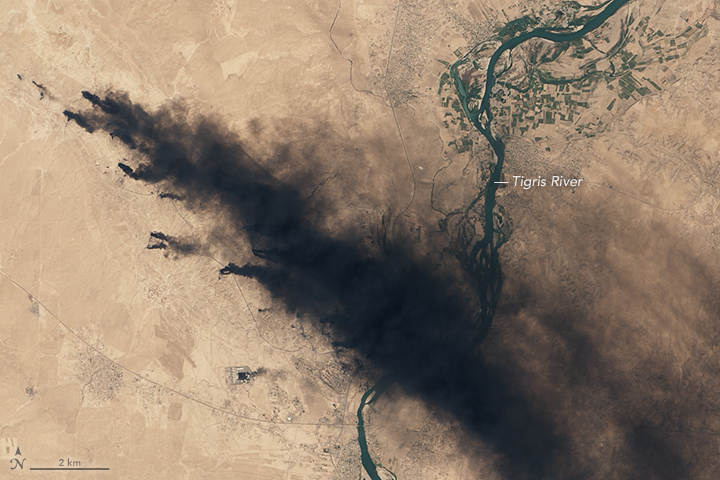
The pessimism of purpose in the world extends to the and infects the warming of our global temperatures, as if to condemn us to a history of carbon extraction of which the Gulf War was the iconic turning point. Temperature rise is easily seen as part of a pessimistic world picture we cannot intervene, as if evidence of inevitable products of life of a carbon-burning age, the rise of temperatures. the age was spurred by the billions made from the postwar extraction of carbon-rich fuels have been the stimulus of an overheating planet, bringing temperatures of oceans and land alike–albeit in importantly different ways–to a tipping point, starting from that harrowing moment of apparent apocalyptic images of burning oil wells in 1991, the spewing of tarcrete seemed to confirm the arrival of an age of the Anthropocene before the word emerged in the critical literature–an age defined by the spread of economies of extraction as the dominant means of moving far beyond sovereign bounds.
The increasing quantities of “accidental” spills that have been occurring in the United States since 2010 alone have led to a blossoming of pipeline leaks, shipping accidents, train derailments and industrial disasters that have revealed the downside of the extractive industries the government overabundantly subsidizes and funds: over half the spills were of crude oil, and a further third petroleum products, and a sixth highly flammable gas. The small number of leaks of ammonia and other highly volatile liquids made from petroleum should not detract from their high levels of their toxicity: the greatest number of accidents of costly crude spills whose clean-up can continue for years range from petroleum products such as diesel or gasoline, to liquefied natural gas or crude, have an unsurprising epicenter around the Gulf of Mexico, per Visual Capitalist‘s Preyash Shah, and can include the very liquified CO2 products under high pressure regularly transported in pipelines, commonly used for carbon capture storage. If almost have of such spills have been mapped in Texas (site of 40% of the almost 5,000 spills that were mapped in the twelve years 2010-2022, the leaking of crude and natural gas plumes across the density of offshore platforms along the Louisiana Coast is downright terrifying.

U.S. Oil and Gas Spills, 2010-20122/Visual Capitalist, 2022
It is all too problematic that the very same companies benefitting form gas and oil extraction are now at work–from Occidental Petroleum to Exxon Mobil to Chevron to Shell–on the unproven Direct Air Capture technologies, misleadingly billed as a means to achieve emissions reduction goals set in the recent Paris Climate Accords and as the corporate ticket to “carbon neutrality.” This is the new gospel of a soft neoliberalism in which the government would outsource aging infrastructure of energy extraction to capture carbon from the air at the very site of its release by energy corporations. If a “soft neo-liberalism” at the edges of the nation state, the expansion of public-private partnerships that extend offshore into Gulf of Mexico, beyond the edges of the nation, are haunted by the terrifying LandSat images of a landscape of hundreds of oil fields burning out of control.
For in reaction to the 1991 arrival of American-led “boots on the ground” forces in Kuwait, who waged all-night battles on the Euphrates, Iraqi troops repurposed the underground reserves of subterranean oil fields to super-abundant Molotov cocktails thrown into the atmosphere far beyond sovereign bounds. The striking televised footage of the global dispersion of carbon ash, that almost replaced teh expectant footage of a ready and easy victory, anticipated the billowing towers of the foormer World Trade Center, belching black smoke from the combusting contents of the tankers of airlines that later flew into the twin towers. If the towers billowing black smoke in lower Manhattan was an icon of the War on Terror and of the Gulf War, the unstoppable release of those hundreds of oil fields senselessly burning oil, as if to reappropriate the crude bound for western tankers in the Gulf, and energy markets abroad, the staking of oil sovereignty in the Atlantic seems to bring the reserves extracted far, far closer to home. T he unpromising and unproven promise of carbon removal by Direct Air Capture seems to rewrite the wounds of Middle Eastern wars of oil sovereignty closer offshore, mapping a new image of petrosovereignty in an age of Empire. Carbon removal is promoted as a way of justifying petroleum and gas extraction in an era of extreme climate change–and climate activists urged to support carbon removal by Direct Air Capture even as oil companies have treat it as grounds to continue drilling, producing and using fossil fuels.
We are argued to have no other option, but our backs are up against the wall if we hope to stay the rising of ocean temperatures. There may be virtue in recycling, but the density of this color spectrum, tending from red to carmine, only illuminate a massive shift on a scale we have no clear ability to presume a personal relation to–or perhaps even the cognitive ability to grasp fully. We stand before these maps haunted by a deep dread, a fear that is perhaps debilitating more than empowered, but perhaps diminished by what has preceded, and with no sense of rational decision–although we are tempted to arrive at many a quick fix to steer back from the apocalypse of warming oceans. Can the deep reds be anything other than a warning of warming to come, a continuation of the global trends of dramatically increased ocean warming and sea surface heat.

Trends in Global Sea Temperatures in Twentieth and Twenty-First Centuries (1901-2020)/EPA
The rasterization of the global ellipsoid suggests a dangerous distance from the mechanics of warming, even if it maps the globe on a jarring color ramp we have not seen before, or are likely to be able to interpret. The very etheriality of these raster maps of temperature anomalies are striking as they cast the ocean on a distinctly red color ramp. As if in synchony with the massive waves of coral bleaching in global oceans–whose impact and scale we cannot yet calculate–we find things of the impending nature of ecosystemic colapse that fills with palpable dread, but is more striking in its absence of any fitting narrative. If the story is tragic, and existential in scope, the cognitively disarming nature of these pixellated maps are as strikningly removed from any material basis, and lacks any clear distance to comprehend as it is bereft of any narrative.
It seems the lack of clear narrative, and the alarm of red, leads to such perhaps well-intentioned but tragically desperate cries for help as Just Stop Oil protestors calling for the immediate end of fossil fuels by using orange florescent spray paint to target the neoclassical Radcliffe Camera icon of Oxford’s Bodleian Library, spraying a fluorescent orange on a structure built 1737-1749 to embody Enlightenment ideals. The Palladian domed building might typify the Enlightenment, targeted as if the root of deep ignorance of the consequences of extraction, but also illustrates an inability to imagine any end-game save cessation of use of extractive fuels across the entire global economy. The rugged demand–Just Stop Oil!–suggests a purblind view of the interests at play–is it only government or any government, or isn’t the problem a little more manifold? can orange spraypaint to deface a heritage structure really make a mark, or is it just a muffled cry for help?


Hugh Warwick/October 10, 2023
Welcome to truly desperate times. The intense orange removed by power0hoses hours after a disgruntled Oxford student and his mate seem to have repurposed the immediacy of Nike’s corporate slogan suggest nothing less than an existential sense of the teetering image of the world’s environment that could not but echo the insisted on recent temperature trends that have lasted the lives of the ecological activists, twenty-one and eighteen year respectively, taking a stand against the markedly uncontrolled increased warming of land areas and wildly shifting extremes of seasonal temperature that had led to the expansive melting of arctic regions. Following the alarming colors of temperatures changes NOAA features on the Climate Dashboard, the spread of rising temperatures by over half a degree Fahrenheit/decade are truly causes for alarm.

Climate Dashboard: Changes in Climate Temperature by Decade , 1993-2022
But the deep orange hues of the slogan of the Just Stop Oil folks earnestly demanding “no new oil, no new gas or coal” are calling for a “deliberate disobedience” that the spray-painting of Radcliffe Hall–a symbol of Oxford–inaugurates across three weeks of action from October 29, akin to a reckoning, designed to appeal to students, promises a greater sense of agency and empowerment in a world where “No-one’s going to save us, we have to come together to do that for ourselves” in time for Halloween, as if to grab the steering wheel on a car that has been driving out of control, and force the hand of civil government by collective actions of “deliberate disobedience”– assuming equivalent existential urgency of the dispossessed: “what will the Government do? Concede to our demand, or crack down and arrest us all?” The Oxford protests, on the heels of the spraying of Bristol’s Queens building with the same bright orange paint, urging all faculty and students to join in the “civil resistance,” led to the Oxford student to claim to be “taking action to resist the destruction of my generation,” noting the scale of the climate crisis of which “Oxford academics are fully aware of,” but despite knowledge of fast-approaching “unsurvivable heat and humidity” that will force “hundreds of millions of people will be forced to move, or die” is tantamount to genocide.
Before “the annihilation of everything we care about,” the Oxford student who defaced a site of study by florescent orange paint seemed to interrupt quiescent study. On the heels of the spraying of a building in Bristol’s Queens building with analogously orange industrial paint, asking all university students and faculty to unite in a “civil resistance” to extractive energy, the Oxford undergraduate felt he was “taking action to resist the destruction of my generation” in existential terms, decrying how “Oxford academics are fully aware of the scale of the climate crisis” but ignore it. As a member of Just Stop Oil, a coalition committed to forcing the government to end “all new licences and consents for the exploration, development and production of fossil fuels in the UK,” he was confined of the need to stop a narrative of planetary warming that has an inevitably tragic end.

Have we failed this generation, and indeed failed the cause of climate change, by maps that assume an impending disaster of warming that offer no possibility of change or berth of safety or remove? This seems a Eurocene, to be sure, as much as an Anthropocene, of unconscionable harm to habitat range, environment, and ecosystems as a massive amount of energy has been insistently raising global temperatures by extra unwanted heat. The recent rasterization of our ocean maps–we map less bathymetry than temperature anomalies in the daily coral reef watch–recast the ocean as haunted by color ramps we have never seen before, pressing us to create stories and gain a grasp on what has been happening with the oceans as they warm in dangerous directions across the north.

The liability of such raster maps may lie in their eery ethereality: a pixellated space distances us from the materiality of climate change. For rasterization problematically offers an eerily immaterial way to view global warming unhelpful in its terrifying immateriality, as if blocks of predestined pigment sprayed across the ellipsoid outlines globe at a distance and from on high mark the bleaching of ocean life. It is terrifyingly inappropriate not only in its lack of narrative–if the story is tragic, and it is existential to boot–but cognitively disarming as it is removed from any precedent, wrapping the surface of a globe as if spray-painted across the flat ellipsoid disk we struggle to map to particular losses, filled with forebodings of increaed global warmth.
But we have hard time focussing on the shores as endangered areas by the disproportionately warming global ocean, overwhelmed by data that we are cognitively challenged to process. The late historian John Gillis warned us often of the danger of such assertive and short-sighted “turning one’s back on the sea”–and Gillis was worried that we had done so as a culture and society to our great detriment–rising ocean heat and sea surface temperatures remind us of the disproportionate amount of heat that has been absorbed in global oceans, and the danger of having remade the ocean as a vital habitat. For the shores have been unjustly ignored, as a space whose ecology we might do well to focus as sites suffering from anthropogenic change. We have a hard time focus on the vulnerability of the shores as ecosystems, indeed, so often do we see surging seas as a threat to human habitation of the shoreline, rather than having a broader sense of the threat to the ocean biome as a threat from largely anthropogenic warming. Yet as they are so vulnerable, and so potentially rich with significance as vital membranes of the planet. they are precisely where we must attend with greater atteniotn, as we try to parseunprecedented risks of overheating.
Even as country-based promises to reduce rates of carbon emissions became the talk of the town after the Paris Accords, with few imagining reductions likely for most of the developed world, before the United States withdrew from the global accord, which had pledged to cut 52.4 billion tonnes of emissions, on a global scale, little probability of the reduction to goals by the highest emitters–China; Western Europe (EU); Brazil; Canada; Japan–we face the global impact of planetary warming with few guideposts, precedents, or narratives to process catastrophic climate change.

We risk casting anomalies of surface temperatures and indeed looming rises in surface temperature as but the latest flattening of the world’s surface, eliding differences of land and sea temperatures that fails to come to terms with the cascading consequences and scale of anthropogenic climate change. For the most striking aspects of the rising surface temperatures on the planet may be the rising warmth of ocean waters. And the registering of global waters suggests, not paradoxically, both the liability of a focus of most mapping on the land–and extension of terrestrial coordinates to the oceanic surface, as if the anthropocentric claims of land maps might be extended, with brash or unwarranted assurance, into the ocean, without appreciation of the degree to which oceans have absorbed the great preponderance of anthropogenic heat: does an anthropocentric map of land effectively elide the extent of anthropogenic influences on global surface temperatures? Offering a private record to observe temperature variations that are remotely sensed, we may be foreclosing our relations to our own surroundings, and indeed of the relation of species beyond the human to the oceans as globally vital habitats.

But in mapping temperature rises as part of a continuation of land temperature anomalies, we may not grasp the full extent of the problem–and only risk entering into a climate apocalypse. So, indeed, runs the presuppositions implicit in the newly vaunted technologies of Direct Air Capture (DAC), the neo-liberal promise of carbon sequestration, by projects promising to capture carbon at the sites where it is produced that is being entrusted–bottled at the source!–that seven of the largest oil and gas companies are promoting as a public-private venture to “remove legacy emissions” even as the oceans warmed. For DAV is billed as the new mission of energy companies to use their existing infrastructure in offshore a reas to make good on the danger of the climate scenarios such maps threateningly propose, treating the recent promise of Direct Air Capture, if unproven, as a awaits public funds to “flow into the [existing energy] sector so it can scale,” with Occidental Petroleum floating promises to remove one million metric tons of CO2 every year by what is billed as a model for what the “best, most sophisticated, most committed companies” in the oil and gas businesses who are rooted in extractive industries should do “to preserve our industry over time.” Occidental Petroleum’s CEO is making a rather desperate argument as the nation’s energy companies have their backs up against the wall if they want to continue to emit more carbon, with carbon being the prime contributor to and accelerator of anthropogenic climate change.
For if its technology is unproven, it ostensibly or plausibly offers carbon-based energy companies an basis to sustain DAC can leverage a write-off able to balance out costs of future carbon emissions by using machines on the drawing boards to “pull carbon from the air” of unproven efficiency, erasing future costs of carbon burning, and overlooking the past costs of carbon emissions energy companies have themselves so conspicuously historically contributed.
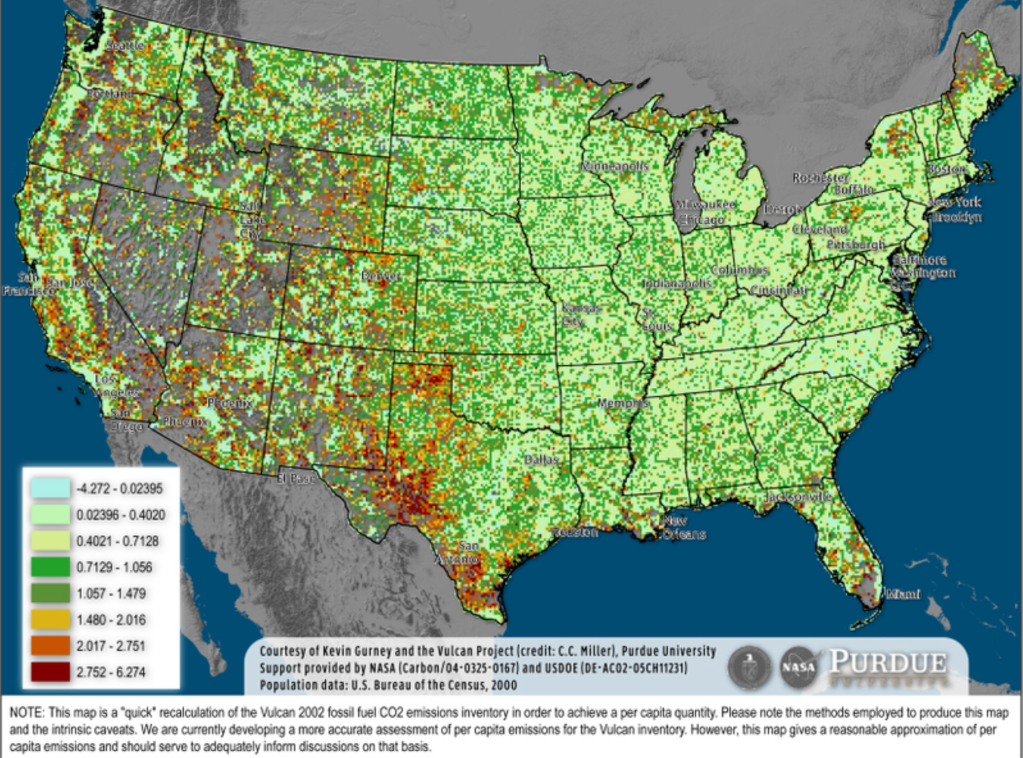
Fossil Fuel Emissions Inventory per Capita based on 2000 Census/Kevin Gurney and Vulcan Project, Purdue
The unproven technology uses the very tools of extractive industry to inject and store carbon in the earth’s surface, , creating a tool akin to double-entry bookkeeping to balance the costs of future energy develpment against the removal of carbon that may well in the end return to the earth’s atmosphere without ever needing to reduce emissions. “Direct Air Capture” is a new language of soft neoliberalism, fulfilling needs to acknowledge the untenable scale of costs of carbon emissions, but scaling up their own responsibilities to reduce emissions by promises to sequester carbon in underground reserves, of putting the greenhouse gases back where the oil was extracted years ago, and indeed filling up old empty oil mines with carbon reserves in the Permian basin. Although the largest DAC plant removes only 4,000 tonnes of CO2 from the air per year, the logic of an enormous growth of investing in technologies of Direct Air Capture plants could eventually and only by the middle of the twenty-first century extract a full gigaton of the carbon released into the atmosphere.

Proposed and Operational Direct Air Capture Facilities, 2018/Global CCS Institute
Global oceans have absorbed a preponderance of anthropogenic heat over the past seventy years– some ninety percent of excess heat that was trapped in the earth’s atmosphere since 1955–that makes them perhaps the clearest single register of the extent of anthropogenic contribution to climate change. Yet our monitoring of sea surface temperature adequate, based on a points, hinders rather than help the scale of climate change that is occurring in the global oceans. It is perhaps a hard pill to swallow, that cannot be sugar-coated, but the deep reds of temperature anomalies present a stronger picture than the levels of temperature rise of the planet’s surface, and its detail demands far more unpacking and deeper drilling into its detail, to use a poor metaphor, to unpack in satisfactory ways.
It is otherwise hard to grasp the alarm registered in the header to this post. The very land-based tools of mapping that have allowed us to track landcover and agricultural productivity by GIS overlays may have been far less helpful in grasping the scale and of the anthropogenic modification of global oceans–and the to grasp the changes in global oceans that will help to process or come to terms with the consequences and scale of rising sea surface temperatures, and the contribution of anthropogenic contributions to rising global temperature that are at risk of changing the global habitat and our relation to the surrounding world at the levels we demand to understand. Fort he very tools of geographic mapping are ones that arose in terms of mapping from the perspective of a state–effectively, of seeing like a state–that led us to understand land use, as much as anthropogenic change. Yet the state has sold increased offshore drilling rights to many oil companies, in ways that have set the stage for planning offshore Direct Air Capture plants in sites like the Gulf of Mexico, increasingly treated by 2018 as a pubic-private density of point-based drilling sites, even as sea temperatures rise. The network of old wells abandoned permanently and temporarily on lands that the the US Government leased to energy corporations suggest a basis for the encouragement of a man-made shoreline tied to an infrastructure of energy extraction by 2018 that was difficult to change or every fully separate ourselves.
Permanently or Temporarily Abandoned Oil and Gas Wells Leased in Gulf of Mexico, 2018/Enverus 2018, National Energy Technology Laboratory, Undated
GIS layers helped engineer the most effective site of carbon sequestration in offshore regions of the well-mapped geological terrain of the Gulf of Mexico, already crisscrossed by a density of pipelines for optimal sites for low-cost offshore storage of optimal geologic suitability, despite the existence of clear risks of locating extractive industries offshore beside a wetlands that bordered on a rich marine ecosystem that was delicately stuctured as a complex oceanic habitat. The reference points for storing are the cities where workers at the new plants would live–Mobile; Houston; Corpus Christi; Biloxi–rather than the ecologically delicate salt marshes, wetlands, and estuaries that are critical to shorebirds, and spawning sites for crayfish, oysters, shrimp, mink and alligators. The choice sites for subzero storage of the coast of Louisiana lie within the offshore continental shelf, as if an extension of territorial claims of the well-mapped underseas regions long studied by the energy industry.

Favorable Locations for Offshore Storage of Captured Atmospheric Carbon, 2022
This may be the fate of the pointilistically mapped seabed, a weirdly compromised cartographic flattening of the offshore. For the oceans–the very life-giving areas from which we arose, and on whose edges human society long lived–offer the clearest register of the anthropogenic image of human-caused temperature rise, although, perhaps paradoxically or more probably circularly, the deeply anthropocentric systems we have mapped or registered land by a point-based system may be inadequate to register the impact of rising sea surface temperatures on planetary health.

Change in Global Sea Temperatures in Twentieth and Twenty-First Centuries (1901-2020)/EPA
–but how much our recent maps of marine monitoring are not evident as much in point-based registering of anomalies, but specific sites of ocean heat, with a troubling density off the coast of Japan, in the Persian Gulf, and in the Gulf of Mexico,as well as the Eastern Seaboard.

Marine Monitoring of Global Ocean Heat Trends, 2005-2019
This contribution is difficult to map, or map to satisfaction as the result of human activities. But the stubborn nature of these deep carmine reds suggest, of course, a change that goes far beyond politics, and, if we might be glad for the light blue airbrushing on part of the Arctic Ocean and Greenland’s edge, the ice-free arctic and warming of antarctic ice shield seems much more terrifying signs of where we are headed, with a warming Atlantic–and Gulf of Mexico–a cause for alarm. If Canadian rock singer Neil Young dryly lamented in “Mother Nature on the Run” that 1970s would change the environment of the planet, his dreamy, druggy, hallucinogenic if anthemic call for help paralleled major breaks from the baseline of global temperatures. For from the postwar era through the 1970s, weather changes reveal the deeply disruptive nature of the global climate to which we are headed–and the step difficulties of visually communicating temperature anomalies. Were increasing surface temperature from 1900-2020 already hinting at the consequences of a failure to incorporate rapidly shifting temperatures farmers would faced by the late 1960s, in a 1970 album reflecting on how rising temperatures of the late 1960s and increased pollution created a powerlessness before a changing landscape, parallel to declining agricultural productivity?
If Young was not necessary a student of the Canadian Land Inventory, as a twelve year old set his sites to be an egg farmer–and to be a student of scientific agriculture at the Ontario Agricultural College to “learn to be a scientific farmer” after having tallied the improvised inventory of “Neil Eggs” as he organized sales of a chicken coop in close contact with Ontario farmers before listening to Chuck Berry, Fats Domino, and Elvis Presley replaced his raising chickens and selling eggs. The environmental anthem anticipates Young’s fierce opposition to factory farming since the mid 1980s, shunning venues serving foodstuffs from factory farms–venues “fed by factory farms.” But the oracular nature of the song covered by Patti Smith, after I’d written much of this blogpost, in Golden Gate Park, first made me wonder how the roots of the Canadian Land Inventory was unsuited to measure the changes in sea surface temperatures and indeed offer a meaningful narrative context for global temperature changes.
Extreme heat itself endangers farm workers–most U.S. farmworkers endure dangerous levels of heat three weeks of each year, beyond historical levels of heat exposure, growing to two months by the current century’s close per a recent study of the actual concentration of agricultural workers in America who will suffer from such a shift against the regions that are in upper quartiles for community resilience–suggesting the lack of abilities we will have to absorb or respond to such critical even if apparently “small” changes in temperature across the United States, shifting the productivity of farms in an era of climate change projected under different models or scenarios.
How to include people in the map, or how to include lived experience of other animals? We have perhaps all retreated into the comfort of our own buildings, retiring to contemplate rasterized images of modeled temperature changes in air conditioned rooms. The shifts in temperatures captured by eye-catching rasters offer limited narrative context to process such rapidly accelerating shifts of global surface temperatures. And if we presume to hope to “capture” carbon to turn back such rapid and unsustainable swings of surface temperatures in future years by continuing to allow carbon emissions, we are perhaps allowing ourselves to be the victims of cartographic distortions that fail to register the consequences of how oceans–in ways we have not fully been aware–have been absorbing up to 90% of anthropogenic global warming.
The arrival of July brought the warmest July on record–tempting a bitter riff on Stevie Wonder’s album by calling it “Hotter than Julys” about “making the earth a burning fire,” over a full degree centigrade–1.12°C (2.02°F)–above the 20th-century average of 15.8°C (60.4°F), raising questions of mapping anomalies meaningful, as the monitoring revealed a level of warming so beyond average that one might distinguish record temps warmest as something that the entire planet had not experienced, and that raises questions not only about the world, but our relations to the world–the Umwelt, that zoologists appropriated from idealistic philosophy at the turn if the twentieth century to acknowledge how different species used the senses to map external lived environments –that we are going to be forced to come to terms as our environments reached record heats.
The agency of animals in perceiving the world is less the point of this post, however, than the radical accomodation of Umwelt that such record shifts in ambient land and sea temperatures pose–and how we can recognize and communicate them beyond simple color ramps. The recent record marine temperatures raise questions of the warming of sea surfaces, in fact, that demand to be distinguished as a reservoirs of heat we have perhaps poorly mapped in describing the land-sea continuity of maps–a continuity that was long heralded as a modern innovation of terraqueous cartography in the early modern world–that might be less helpful when it comes to grasping the effects of heating oceans and the rising sea-surface temperatures and oceanic heat waves remote sensing tools currently reveal.

Record Land and Ocean Temperature Percentiles in July, 2023/NOAA
The pinning of heat to pixels renders not political polarization, but even more toxic disturbances of equilibria of global temperatures–but an even more bracing problem of organizing our relation to a rapidly warming world. These quite literal heat maps paint a scary picture of the complex distribution of warming across land and sea over a century of of warming, synthesized from the first era of fairly uniform data in global temperature maps.
But are the rasters tracking warming able to communicate the imbalances of these significant anomalies of global warming by almost three degrees in some spaces of the global ocean–and some a few regions–an increase that follows the yearly rising of surface temperatures from just before 1980. This was the very time that Young–son of a prominent Canadian newspaperman who as a daily columnist for the Globe and Mail had a knack for reporting–was chronicling quite recent spiking in global surface temperatures before 1970 when Neil Young called our attention to the new scale of pressures we put on the planet, at what would be watershed of rising temperatures that only escalated over the next fifty odd years. By some odd coincidence that may not have been that odd, Canadian government began to monitor land-use management in ways that would lead to the formation of early geographic information systems, as Canadian geographer Roger F. Tomlinson began using aerial surveys–using large-scale photogrammetric maps–to create visual information forms bridging computers and geographic data. By collating data about wildlife, forestry and the census to increase agricultural productivity, Tomlinson offered new ways of seeing like a state rather than like a farmer, in ways that claimed a benefit for farmers and farms across Canada..
But data on resources was privileged beyond data on warming–“heat” was not even a category of inventorying land information in maps, at a uniform scale and overlay, in ways that allowed “layers” to be read overlapping factors on a basic dot-grid, able to incorporate census data, that would reduce the manpower for resource mapping beyond the capacities of actual staff. Canadian surveys amassed databanks beyond human abilities to assimilate an inventory of land-use information, able to store information in readily usable form in a computerized inventory of overlapping layers jto process the scale of information overload in maps of environent, land use, and productivity that humans cannot process or analyze in an instant library of statistics stored on tape, but not maps–even as any point on the earth’s surface “can be identified by numbers” to allow a synoptic inventory of land quality to devise new practices of land use.

Tomlinson coined of “Geographic Information Layers”–long before he joined ESRI, down in he San Bernardino Valley outside of Los Angeles on the Pacific coast–as a public respository of land use. The weighty term itself predates a century of rising heat, however, and its inventories largely bracketed temperature and the effects of heat waves’ differently deleterious effects on land and sea. The Canadian government was presented by Tomlinson as the landowner akin akin to a farmer forced to make decisions but who had “hasn’t got too much idea about the climate” or the water on his property he has just inherited, forced to make decisions about how to plant the right seed for his family. The very same questions, he explained in a classic CBC promotional short, were pressing to addressed both by the farmer who inherits a plot of land, but can be extrapolated to the nation’s management of millions of miles across Canada in an inventory.
The result that “the map has been converted into numbers” allowed readings of land quality at every hundred feet across the country, now readily accessed in hours, stored on tape on a grid aligning census tracts, water rights, and the fertility of the soil, placing jdata in the hands of decision makers in a public library of land. By replacing the human eye’s relation to landscape by an interface of soils, climate, topography, wildlife, forest capabilities and census tracts by subdivision in a profile of the nation, map layers were analyzed at multiple scales to zoom in on local land use at points and polygons,–


Saskatchewan’s Land Capaibility for Wildlife, Canadian Land Inventory (1976)
–merging files and coordinates of the Canada Land Inventory that have provided abasis for optimal land use and government investment that offered a tempting basis for similar inventory of the nature of atmospheric changes on a global scale. Yet a farmer’s local knowledge is different in feel and texture than the point-based layers Tomlinson optimistically advocated as a national mapping model–in ways that is not captured in the massive inventory that classified the land.
But the land use inventory presumed a stable definition of “nature,” that he current escalation of temperatures when Neil Young composed his anthemic song about Mother Nature being “on the run” as a fugitive or convict around 1970s, as temperatures started to rise yearly, shifting the crop yields in the data that Tomlinson measured for he Department of Forestry and Rural Development by stacking up layers that would align point-based data for cartographers’ benefit on any land-map.
Neil and his father Scott Young famously lived outside of Toronto, on an Ontario farm, and would have been aware of the Land Use Inventory, but also of the problems of a shifting sense of nature that it did not easily capture in its discrete point-based layers of information. Yet the rising surface temperatures of the late 1960s and later years that won a large and continued audience for Canadian guitarist Neil Young’s anthem in his first great solo record was rooted on working on a farm responded to the increasing anthropogenic nature of rapid temperature change–as much as the fears of nuclear apocalypse and technological advances–that inaugurated an escalation of above-average land temperatures through the first fifth of the twenty-first century far beyond what Young himself had feared or envisioned, difficult to reduce to but a single layer of a map.
Surface Temperature against Average (°C/NOAA, data: National Centers for Environmental Information
We are not cognitively attuned to imbalances, and dramatic departures from the status quo. If cognitive biases that lead us to prefer status quo relations where things remain the same are common basis for poor decision-making, the desire to prefer that things stay the same is an especially pernicious error in assessing the anthropogenic contribution to climate change: we allow ourselves to be seduced to maintain the status quo, to minimize risks, but have occluded the imperative and huge benefits of reducing the disruptive cascade of ecosystemic shifts of such consequence to be impossible to process in terms of the two-color schema of red and blue.
It is hard not to worry that the tools of registering such rapid shifts of surface temperatures offer a poor sense of our relation to the natural world–or help to clarify the rapid shifts in the biological of the world that will be and are experienced by other creatures. For the stark shifts of temperature changes map a misleading balance sheet of environmental change that is oddly distanced from the relation of organism to the planet, or a tally of benefits and costs that occlude the relation of organisms to the to the surrounding world, that should be the true centering of any understanding of climate change. The compromised relation to surrounding environments that the plotting of value in underground deep-sea energy reserves is a distortion privileging the point-based location of value, removed from the oceanic environment or critical dangers of warming waters of the global ocean waters. As the habitats of oceans shift in irreversible ways, the ability of creatures to relate to the world, or to perceive their surroundings, changes, and we are caught, as a deer in the headlights, without a clear way to grasp either the scale or effects of changes in the global ocean.
We trust we still have time to withhold judgment–as if fears of losses of once abundant petrochemicals can occlude an appreciation of potentially hugely favorable gains, driven by fears that declining oil prices might hinder profits to drill over 50-60,000 more new oil wells annually–
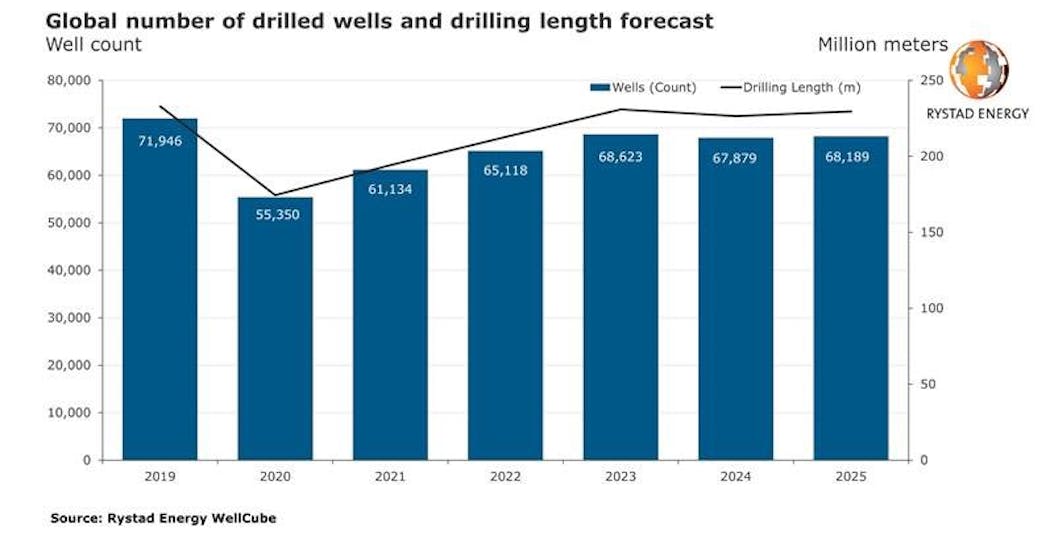
and as the expansion of inland drilling in the southwest’s Permian basin has continued to expand of every increasing depth, reaching unwarranted heights, driven by demand for profits and continued petrochemical security, driven by the illusion of an abundance of underground petroleum reserves. nd the increased depletion of near-shore wells that were drilled off the Louisiana coast in the Gulf of Mexico back in 1938 have led to the growth of an offshore archipelago of 3,500 platforms off the continental shelf of the United States, and along the continental slope, leading to a boom in wells under a thousand feed of water on federally leased land–deepwater and ultradeep rigs, whose risks challenge notions of environmental responsibility in a larger network of active gas and oil pipelines, processing plants and offshore structures in leased lands on the outer continental shelf.
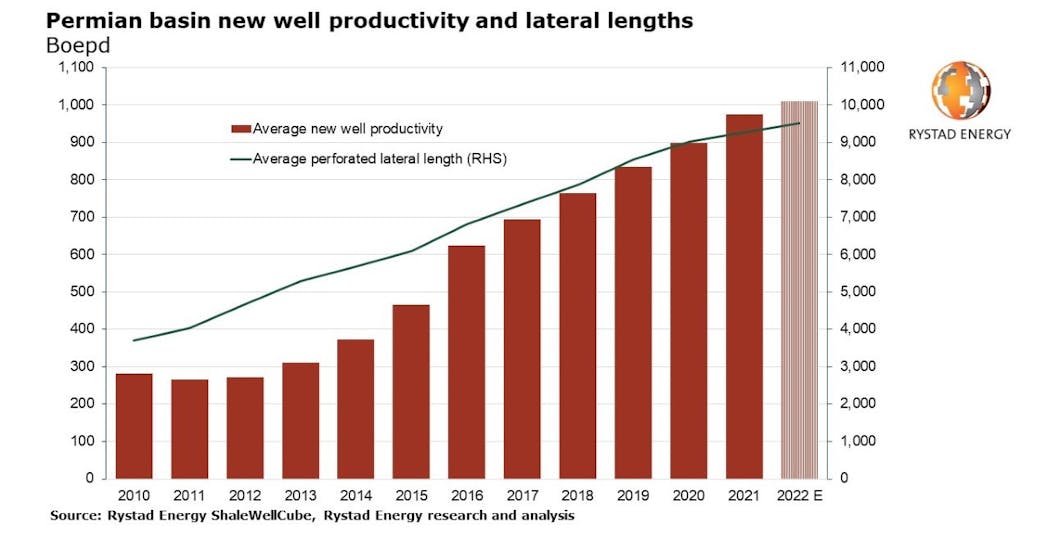
New Wells Drilled Annually in Permian Basin in Texas and New Mexico
Perhaps we have little clear ways of registering the scale at which anthropogenic contributions add to the warming of the global ocean, or of planetary seas. We have no clear basis to represent this growing contribution, let alone to narrativize or narrate our own relations to the rapid acceleration of climate change and its multitude of consequences of a warming world. Our maps are not at fault, but have their limits as they reify the conditions we live in–rather than our contribution to them, whose specter is perhaps all too evident in the world’s largest gulf, a marginal sea of the Atlantic whose seaward boundaries provide one of the greatest challenges of coastal management.
The Gulf of Mexico is itself an anthropogenic space, where’s the seamless bridging of land and sea: as well as a proof-of-concept of liabilities of mapping a continuity of land and sea by leasing of federal lots for platforms for extracting oil and gas of increasing depth, far deeper than five to six thousand feet below sea-level. The expansion of deepwater mapping has grown dramatically since 2000, by energy companies growth eager to match demand for gas and oil as abundant in “national” waters; the government is eager to license to ensure the ability to “keep” energy prices down. If the current plans to invest billions in unproven tools of “direct air” carbon-capture promises a reduction of greenhouse grasses and new commitment of industry to greening, by “vacuuming” emissions at their source,” that would allow us to address the “carbon problem” with no change in our consumption of fossil fuels. Even as it promises of erasing the onerous emissions are unproven the promise to allow carbon dependence is widely promoted by energy companies: public funding of Carbon Capture and Sequestration would sanction the continued expansion of the largest offshore energy infrastructure in Texas and Louisiana, and boast the adoption of the best mapped geological region to sequester captured carbon for 559 BN metric tons of carbon storage.

Offshore Carbon Sequestration in the Gulf of Mexico/Helen G. Prieto
The promise of investing public funds in a boondoggle of corporate “greenwashing” is promoted as the “evolution” of a new American landscape of Carbon Capture and Storage (CCS), by subsidizing Occidental Petroleum to build corporate-sized “direct air” carbon capture and storage plants ready to imagine as a a new national infrastructure dedicated to construct “hubs” of carbon capture to be piped to “injection” sites where it might be stored or “sequestered.” Planned carbon “sequestration” projects are paired with green-lighting bids for offshore sequestration on federal lands lying in one of the most studied geological basins and potential sinks, the Gulf of Mexico–a site of expansive offshore energy infrastructure that is currently promoted as “the largest volume regional geological sinks in the United States for large-scale Carbon Capture and Sequestration.” The region that has a large number of depleted oil fields, already owned or leased by energy companies, essentially, is promoted (and extrapolated) as a bonanza of Gigatons of carbon storage.
The continued mapping of the man-made offshore environment of the Gulf of Mexico is plotted as a prime site to capture of carbon. The transformation of the Gulf of Mexico to a site of future carbon storage fulfills a fantasy of absorbing fossil fuels’ pollution from the skies without reduced dependence on petrochemical fuels, detracting attention from the very edges of marine habitat oil and gas extraction threatens. The very premise of “Direct Air Capture” takes eyes of the maps of global warming and many modeling of the effects of ocean warming.
Proposed “Direct Air Capture” plants would imitate the very functions performed by the very coastal ecosystems–salt tidal marshes; kelp ecosystems; and even the open ocean–or are argued to do so on a broader scale than the sequestering and absorbing of one to two tons of carbon per hectare in existing salt tidal marshes, or the Florida Everglades, whose mangroves and peat soils have huge carbon stocks, and carbon sinks valued at $3 billion, if reduced by pollution and climate change. Spending over $6 billion in carbon capture projects along the Louisiana coast to sequester the carbon produced at refineries, making the state’s coastline into the carbon capture capital of the American South–but suggest the abstraction of costs and balances of carbon in maps of unproven possibilities of capturing carbon across the state, even as ocean temperatures rise at rapid rates.

Industrial CO2 Emitters against Potential Biomass Residue Availability/Carbon Mitigation Initiative
Yet the seductive promise and premise of carbon capture is perhaps best understood as a way of keeping the actual problems of anthropogenic global warming that has already shifted the qualitative character of our global oceans in increasingly irreversible ways. The operational metaphor of “vacuuming” carbon at sites of emission is billed with unwarranted optimism as a technological fix for states that are notable CO2 emitters who produce potentially dangerous biomass residue. The trust in technological fixes claim that coal-fueled plants can continue to burn brightly, but stored underground, as more petroleum and gas is removed from the offshore fields by “blue hydrogen” or “green fuels” that claim energy companies can lower their carbon profiles–by giving license to further pollute, and place continued risks and environmental stresses on the Gulf of Mexico. While the coastal forest in the watershed of the Mississippi as it enters the Gulf might sequester two to four tons of carbon/acre, annually, if rehabilitated as a “blue carbon” reserve by conserving, replanting, and restoring coastal forest, black mangroves, and receding salt marsh.
Yet investment flowing to carbon capture diverts funds of energy companies from projects of coastal restoration, that is pressed to reduce massive emissions of greenhouse gasses by energy companies, as we continue to burn increasing quantities of extracted carbon fuels–a decade after the goals for reducing emissions were set, and carbon emissions began to fall nationally. Might we not better call out the illusory promise of DAC not blue-washing, obscuring the effects of prospecting and extraction from global oceans acutely felt at the delicate habitats of coastal edges? For only by looking more at these edges can we fully come to terms with the anthropogenic environments we have created, subsidizing energy companies at the hopes of reducing the prices of energy in national markets in responsible ways, and come to terms with the blinders we have kept on the extent to which we have redesigned the coastal environment of a our “national” ocean of underseas energy reserves for national markets.

The building of projected “Direct Air Capture” plants at a rate of thirty a year from 2020-2050, per the International Energy Associations, and fifty a year from 2030-40, and forty 2040-50, would allow global energy consumption to grow, and the petrochemical plants to expand with them.
Would not such plants–and areas for geological storage of CO2–not be a bonanza for energy providers, as their prohibitive cost would demand public funding to delay and eventually reduce their huge cost, to allow air travel to be a climate-neutral, or of net-zero emissions, while it relies on carbon fuels, and the plants’ own costly operation be run either by renewables or non- or low-carbon fuels. The geography of “renewable energy sources” and “CO2 storage” provide a numbing assurance that erase the salience of the very useful artifacts of these global anomalies, treating the world’s surface as a smooth repository for “storage” of the gasses that accelerate climate change.

Existing Direct Air Capture Plants and Planned CO2 Storage Facilities/International Energy Association
If the hundred and thirty DAC plants are allowed to proceed, they are argued to guarantee net zero emissions by 2050. But the promise that the plants are argued to gain efficiency and reduce costs only by a huge investment of funds in an unproven technology, although we have already begun to cataclysmic effects of a warming oceans. Are we not being invited to adopt a selective amnesia of the huge effects of off-the-charts anomalies of land and sea temperatures and their effects?
This post, ranging widely over ocean space, seeks to given more materiality to the screen-like maps of ocean anomalies that have provided the most common media we rely on to grasp climate change with the necessary detail or grasp. Specific sites provide a basis to drill down these global anomalies onto on a local level. For only by doing so can their dizzying array of detail be fully appreciated and taken stock of for its effects, and the scale of anthropogenic change be appreciated. The useful “baseline” of a land-sea temperature might be appreciated as an artifact of postwar globalization–transverse global grids having been adopted roughly contemporaneously by German Wehrmacht aerial photography and the United States Army Corps of Engineers as the coordinate reference system for global war, due in part to the professionalization of cartographic corps and the challenges of mapping across borders in World War I, pragmatic questions of firing and land-sea coordination, as well as working across the often separate and distinct coordinate systems of European nations. But the very illusion of continuity of land and sea temperatures are less helpful to appreciate the scale of anthropogenic climate change we have witnessed in recent years and over the summer of 2023. Has the imposition of a gridded map of energy extraction helped to ignore the sensitive and intensely rich habitats of the shoreline and coast–watersheds, wetlands, as marshes–as areas of vulnerability and protection?
The question of linking land and sea temperatures in a smooth surface was inherited from the mid-century postwar era. It has informed the presuppositions of weather maps, and is common to the mapping of extreme global temperatures. But the realization of the intense levels of heat stored and sequestered in ocean waters this summer has sent a jolt through the mapping of rising sea-surface temperatures of extreme intensity far beyond normal, raising questions of how to process a global warming monster of heat stored offshore as it presses against the thin margins of cool coastal waters that crash against California’s shores,–are as terrifying as the maps of recent fires’ spread in an overly dry state, or maps of low groundwater levels in California and other regions. Although the California drought in over, it seemed oddly apt if deeply disquieting that the ocean heat wave now threaten the states’ shores in marine infernos lying off of our green shores.

Category 4 (Extreme) Marine Heatwave off the West Coast of the US, nearly 5°C (9°F) above Normal/NOAA
The intense heat wave satellites recently registered off the coast of California, where I live, was unprecedented as it was a weather system where water temperatures peaked almost ten degrees Faherenheit above mortal, has developed off the West Coast of the US, with water temperatures peaking nearly 5°C (9°F) above normal. As much as the Category 4 (extreme) marine heatwave was an event of local shock, it had been advancing across the Pacific Ocean for them. Rather than registering a deceptively flat synoptic view, the image of marine monitoring is a story that exists at multiple scale, the seasonal weakening of colder deep sea waters that cool the coasts in upwellings may bring significantly warmer waters off California’s coast than habitual for Pacific waters, the “Category 4” Marine heat wave risks provoking offshore harmful algal booms, compromising coastal ecosystems, and causing die-offs in coastal waters of mussels and other intertidal species that risk upsetting the marine food web.
The cognitive confusion of ecosystemic disruption is hard to get one’s head around as it exists contemporaneously at multiple scales. Can one map, however, within those layers, the contribution of anthropogenic influences on these stories of cataclysmic change? The complexity of telling a story about ocean warming–let alone a powerful or positive one–seems to be the difficulty of shoehorning the global scale of surface temperature warming in readily graspable terms. While we live locally–mostly–and perceive temperatures in the atmosphere around us, or the immediate ambient surroundings, processing the terrifying range of global temperatures as anomalies places cognitively demands on us as we contemplate the prospect of weather systems we have no means of controlling, if we are wrong to bracket weather systems among circumstances beyond our control. The difficulty of processing the dissonance between how heat is stored and processed on land and at sea, and indeed out the extent to which ocean waters are storing and sequestering ocean heat may offer the clear-eyed appraisal of the extreme weather systems that have shaped the summer of 2023. The inability to come to terms with the cascading effects of such anomalous warming on such a scale is undeniably existential, and we don’t narrativize existential issues well.
Our maps seem to be challenged, and of little help. The very ellipsoid reference system featured in our global weather maps threatens to distance itself from lived world as a pixellated screen by which we witness global warming with alarm, forced to seek moorings before deep red rasters of alarming anomalies, however, that quite convincingly seem to supersede the geopolitical borders of the nation-state, if not raise questions of scales that nation-states seem unable ever to resolve. The red and blue coloration of the regions of America, set in an eerily similar terms to a map of partisan divides, are even less easy to come to terms–if with effects even far more disempowering.

The recent rasterization of our ocean maps–we map less bathymetry than temperature anomalies in the daily coral reef watch–recast the ocean a color ramps than we have seen before. If the massive coral bleaching of this summer has become a token of the sudden nature of ecosystemic collapse of global warming, the loss of coral reefs a microcosm of climate apocalypse, pressing us to create stories and gain a grasp on what has been happening with our oceans and ocean temperatures as they start to warm in dangerous directions across the north.
The liability of such raster maps may lie in their eery ethereality: a pixellated powder distancing us from the materiality of climate change, rasterization is an eerily immaterial way to view global warming unhelpful in its terrifying immateriality, as if blocks of predestined pigment sprayed across the ellipsoid outlines globe at a distance and from on high mark the bleaching of ocean life. It is terrifyingly inappropriate not only in its lack of narrative–if the story is tragic, and it is existential to boot–but cognitively disarming as it is removed from any material basis, but the map is haunted by a lack of distance, wrapping the surface of a globe as if spray-painted across the flat ellipsoid disk, which we struggle to map onto the particulars of the loss of life in the global ocean. As m much as the dark rids of rising anomalies are located in oceans, it is difficult to link the flousescent colors to the tragedy of the blanched reefs of the Florida keys, whose deathly whiteness of long flourishing staghorn coral, and quite vulnerable elk horn coral, seem blanched if not boiled in the heating up of the ambient coastal oceans of which we are suddenly all shocked observers.

Coral Reef Restoration Judges the Bleached Coral at Looe Key Coral Nursery/Jason Gulley
The absence of boundaries and sovereign spaces from the map of temperature anomalies tells a great lie of the uneven distribution of warming, apart form the different contributions of individual nations to the release of greenhouse gasses and carbon fuels, and continued extraction of carbon-based fuels that have been the predominant contribution to temperature change. If the ellipsoid without national borders is indeed an icon of globalization, it too handily lacks any accounting or inventory of the contribution of greenhouse gases to climate change. Global warming was long the greatest treat to coral reefs of global oceans, as algae leave–or “jump ship”–from the living tissues of coral polyps, even as ocean acidification has slowed the growth of coral skeletons needed for a vibrant ecosystem. If coral blanching has gained heightened attention as a die-off in our coastal waters, fed by the dramatic images on globally streaming media, global oceans have already been widely impacted by warming since 1950, dramatically decreasing the biodiversity of these delicate and unique habitats in oceans by a stunning 63% since the 1950s. Ocean heat waves of direct anthropogenic creation have dramatically triggered mass coral bleaching events of reefs already compromised by overfishing and inadequate ecosystemic protections.
Global coral reef cover declined quite dramatically below the baseline in the early 1960s in ways witnessed by indigenous cultures who sounded alarms for conserving reefs by a more sustainable blue economy, as if monitoring of reef ecosystems was only registered as coral bleaching approached national waters of economically developed nations. As bleaching has entered the EEZ’s of developed nations, we would do well to take stock of the deep dangers of the myopia of global warming. The scale of global diminishing of reef cover by over 50% from 1957–2007 is parsed by shifting rates of loss of coral coverage ranging from 4.7-6.8%, even as Caribbean countries, Thailand, or Japan saw modest increases in reef health, didn’t gain global attention until it arrived at our geopolitical doorstep, even if long feared. Even as some 90% of living corals in global reefs were lost from 1980 to 2020, projects of coral restoration–suspiciously funded by the United Arab Emirates. But as the recent spate of uncontrolled tragic wildfires across the island of Maui have led to a sudden worry about the entry of carbon into coastal waters on rare coral complexes of long tourist attraction of its pristine beaches, the threats to coral ware only seen once they are on our doorstep. Maintaining the array genetically diverse varieties of twenty species of coral, of over 1,3000 putative genotypes, poses challenges not only for marine sanctuaries but a globalizing world as oceans warm, driven predominantly by global consumption of fossil fuels.

Changing Percentages of Coral Cover In Exclusive Economic Zones, Tyler Eddy, et al, 2021
The shifts in the blue landscapes of coral cover suggest that the cataclysmic collapse of reefs off of Florida’s coast was not so sudden or unexpected on a. global scale. Yet ecological safeguards and monitoring were not yet attended This post suggests some ways to re-materialize those anomalies. By rendering them not only as a wash of rather inevitable ineluctable tides wrapping around the ellipsoid, those pixels might be more clearly cognitively rooted in material geographies of overly rapacious petrochemical extraction of petrochemicals that has given new meaning areas lying in the offshore those coasts. For the spaces that suddenly gained new materiality in the postwar period of a mania of mapping that led to the reordering of the offshore as a national energy market as an abundant mine of carbon energy for the nation led to an accelerated offshore prospecting, as offshore seabeds gained new materiality in maps as a site able to be extracted for growing energy markets that redefine the seabed and seepage of gas and oil into the global ocean.
Yet the immateriality of our rasterized maps of temperature may distance us from our impact of petrochemical harvesting from the largest ecosystem on Earth are heavily impacted by anthropogenic climate change. Their distancing helps us forget that how, on a local to global scale, it is not only the oceans that have formed a reserve for adverse weather systems, but how oceans have long absorbed human-made heat, and change the very shortest that are among the most diverse ecological areas hosting vital ecosystems, whose stable if quite delicate structure may be a site where changes in climate are disproportionately felt. The point-based pixellated maps of measuring temperature change are dangerously thin as they are distanced from the environment of the ocean, and near-coastal, as well as the coastal environments whose wetlands are so critical to shorebirds, migrating birds, coastal species, and other wildlife.
Nearly 400 species of bird live in the Gulf of Mexico–a “super breeder” environment and keystone habitat–of high avian intensity– from the snowy plover, egrets, spoonbills, to bobbies and frigatebirds who nest in the Southern Gulf of Mexico. These bird populations–and other neotropical and neoarctic migrating populations who use the Gulf as a critical flyover stop for feeding. The coastline may be more threatened by plastics and fishing line than oil, the region already threatened by man-made coastal development–it was not even regarded as a critical areas of wetlands threatened by saltwater intrusion (like northern California’s Sacramento Delta or Delaware) or industrial pollution (as New Jersey)–if that changed by 2010. But the sensitivity to coastal development and petroleum extraction revealed by the Deepwater spill with an immediacy few had imagine, leading to a short-lived push for safety standards for oil and gas to protect threatened flyover habitat by which many migrating birds are nourished as they travel north.

Threats to Migrating Birds in Gulf Of Mexico by Population Growth and Coastal Development
Despite the considerable power by which rasters place into relief a synoptic screen of regional temperature anomalies, their totalistic scope is difficult to parse with the necessary patience and specificity. They invite us to register temperature shifts in the global oceans expected to trigger a change in near-coastal habitat, as if the shores–that site where man historically evolved, as well as one the first sites of mapping, seems in danger of being rewritten, in ways that should shift the focus of our worries from sea-level rise.

When Solnit argued we are paralyzed by our inability to tell a story about climate change, she raised objections of failure of narrative is one of not being able to see a possibility for change, or a livable future: in arguing that we risk being paralyzed by a lack of ability to tell a story about climate change that allows us to see clearly, or creatively enough to understand our power to retain a sense of agency before the massive data of climate change, she may be suggesting we are at risk of being cognitively overwhelmed by and drowned in widely circulating stories of die-offs due to warming, as so many desperate signals of all-but-inevitable climatological defeat–in the polar caps, for example, diminished sea ice thickness create a surplus of ice-melt sends far less salty, warmer water into the global ocean, threatening to shift the colder deep-water masses that drive ocean circulation.
Yet is this not also a failure to map the ocean waters in ways that do not leave us drowned in data? Is the circulation of deep-water masses so remote to be difficult to comprehend in how super-saturated colors that call our attention to global warming, of which the appearance of indigo is so striking and so terrifying–as if blue waters peak through the thin ice shelf on the edges of once floating ice. Does the electric blue swirling about the edges of the arctic shelf that call attention to our eyes as a dangerous abnormality not also register the thin ice on which we collectively stand?
We struggle to encompass both the immensity of a global story that does not drown us in disempowerment. We are indeed acutely aware of lacking a story that presents options for responsibility; we have trouble coming to terms with how to find a place for the local or the individual in totalizing maps whose projections cow us before the gears of an altering climate, their data lying on the surface, as it were, in haunting spills of color whose apparent immateriality makes their actual effects difficult to grasp.
The saturated rasters pixellate a world indelibly haunted by climate change, pools of dark ink swirling to create a tipping point of inevitable rupture from the past. As much as mark an environmental “tipping point,” the effects of global capitalism is to conspire to delay ecological consequences and ruptures, effectively testing nature’s ability to absorb shocks as it teeters toward potential collapse. By casting the thinning ice shelf on the edges of as opening an all but inevitable cascading of still greater, future dangers–projections of sea level rise, coastal flooding, erosion, habitat destruction–we fail to render how technologies of energy extraction have changed the ocean, or the long-term testing of the elasticity of nature by testing the limits of the natural world to absorb increased waste and the detritus of consumption, while extracting and appropriating natural wealth of petrochemicals as a national bounty that has no effect on local ecologies.
If the testing of the first atomic bomb by Robert Oppenheimer was long appreciated as heralding modernity in New Mexico’s desert landscaped; effectively black-boxed, the story of the stresses that it exposed the environment and local inhabitants went unquestioned. The increased effects of anthropogenic pollution are however, as Kohei Saito argues, in a rather telling ecological critique of capitalism, no longer able to be absorbed in the world; we attempt to register the shifts in data in maps, all too often, without trying to tell a story of the inroads of natural wealth or the possibilities of environmental regrowth, if not obscuring the very possibility.
The masses of data in current projections of temperature rise appear all too inevitable–unable to be assimilated to a story, because they seem to truly allow little place for us in the world, or might take our focus off of the hopes for diminishing the accelerated sea-surface warming that may alter global ocean circulation and the rise of the global ocean. Indigo tracery served as hieroglyphics of a future melting ice sheet in 2019, in the cutting edge NASA satellite photographs of Earth Observatory that revealed a melting midsummer pooling of indigo waters in ICESat-2, the most sensitive tool yet to measure the surface of the world’s largest ice sheets in Greenland or Iceland–regions that threaten to add significantly to sea-level rise in coming years, as the world is losing over 200 billion tons of grounded ice annually by the thinning surfaces of ice sheets–as if blue indigo ink were pooling on their surface.

And a clipped elevation raster with a blue color ramp of Antarctica, enlisted indigo to register the increasingly low elevations where the Antartican ice shelf currently meets the sea, as a saturation of deep indigo of lower elevations at the ice shelf’s shore. This indigo demands more materiality.
Is it trying to recuperate the pristinity of the indigo ringing the arctic poles in the very first polar projection by Renaissance cartographer Martin Waldseemüller? The haunting Waldseemüller engraving of the arctic oceans and channels feeding unknown blue waters harbor multiple seas of its own, themselves with islands of uncertain edges. The cartographic rebus–itself a microcosm of the compass–offered an enticingly new vantage on a spherical world–imagined a northern ocean still not sufficiently mapped at whose center lay a giant magnetic mountain at “due north,” from which four flowing rivers combine functional reference points of four cardinal directions with the microcosm in an convincing conjectural cartography of areas few Renaissance explorers explored save Martin Frobisher and James Davis, whose nautical accounts were the basis for invented polar isolario not rendered or appreciated with true interest in most Renaissance planispheres.
The newly mapped “glacial ocean” was no longer the site of abundant fantastic islands, but a separate sea lying as if in wait above the northern edges of the world’s continents, whose frozen islands whose edges had not yet been fully mapped, was a remnant of “T-in-O” microcosms, four frozen rivers flowing beyond a multitude of islands whose edges were, enticingly, not yet mapped, and might well be, as Waldseemüller had wanted the readers of his map to imagine, to be inhabited by pygmies. The fantasia of light blue waters and edgeless islands around the poles was one improbably inhabited by pygmies, whose flower-like perspective on the world opened an iridescent fantasia on map colors, unlike Gerardus Mercator’s maps–the reedition by the Amsterdam based cartographer Jodocus Hondius was more of a hybrid conjectural cartographic rebus, with edges of continents of North America, Asia, and Europe peaking out of the sides with part of California, as if inviting readers to puzzle their assembly of an unseen perspective of the Typhonian, Scythician, Mirmanskoi, Petzorke and Hibernian oceans in the northern glacial sea–Nova Zembla and the Straits of Anián, and a giant whirlpool that threatened direct navigational access–each with a heritage in Russian literature of Vladimir Nabokov or Straits of Anián, to construct as an imaginary division between North America and Asia that offered grounds for early modern cartographers to believe in a Northwest Passage. The current blurring of the pole driven by greenhouse gasses have grown in a new era of globalization, poised to re-blur the edges of arctic and antarctic ice shelves.
Gerardus Mercator, Septentrionalium Terrarum (1606 edition by Jodicus Hondius)
Waldseemuller’s cartographic conjecture of semi-frozen regions of the Northern Pole left its indelible imprint of indigo in recent remappings of ocean currents and the polar ice shelf. If the fanciful assemblage of a quadripartite pole nestling the stony magnetic mountain–a “black cliff of immense height” that created the very same due North on which Dutch navigators had relied was in fact nested in oceans, ringed by mountains just outside where we now place the polar cap, inside the red perimeter of an arctic circle ringing the Mare glaciale, as literary as cartographical space.

Can its imprint of indigo also be an invitation to invest new materiality in a region for which we risk defamiliarizing in rasters? Is the material basis of indigo–a distinct new color of the seventeenth century, not only for Newton but as an abundant luxury import from the Indies, a natural dye–“true indigo”–that was the product of increased global commerce, and perhaps a hint of the new materiality? Deriving as a modern hue of textiles born from a global Atlantic exchange, imported by Spanish colonists to plant and harvest in plantations of the New World, from the Carolinas to Guatemala,–a boom market for in natural dyes was magnified in Europe’s textile wars, and the fueling of its industry by new fashions for striking colors. Unlike the celestial blue of lapis, the market for the trade in textiles was based on a commoditization of colored fabrics that, far from being associated with celestial blues, were signifiers of status in a market of woven commodities.
Demand for textiles was the economic engine of a first era of globalization, from beyond the Indian Ocean to the Americas, as demand for fashions grew capital in seventeenth-century transatlantic trade. If the burning of petroleum and petrochemicals has been by far the greatest engine of the Anthropocene, the dependence of the current age of globalization on unbounded markets of petrochemical extraction that have created an indelible imprint of Anthropocene–extending from global oceans marked by floating gyres of garbage patches to microplastics in ocean waters and the increasingly impreganated plastic seas to the textile fibers detected in human breast milk.
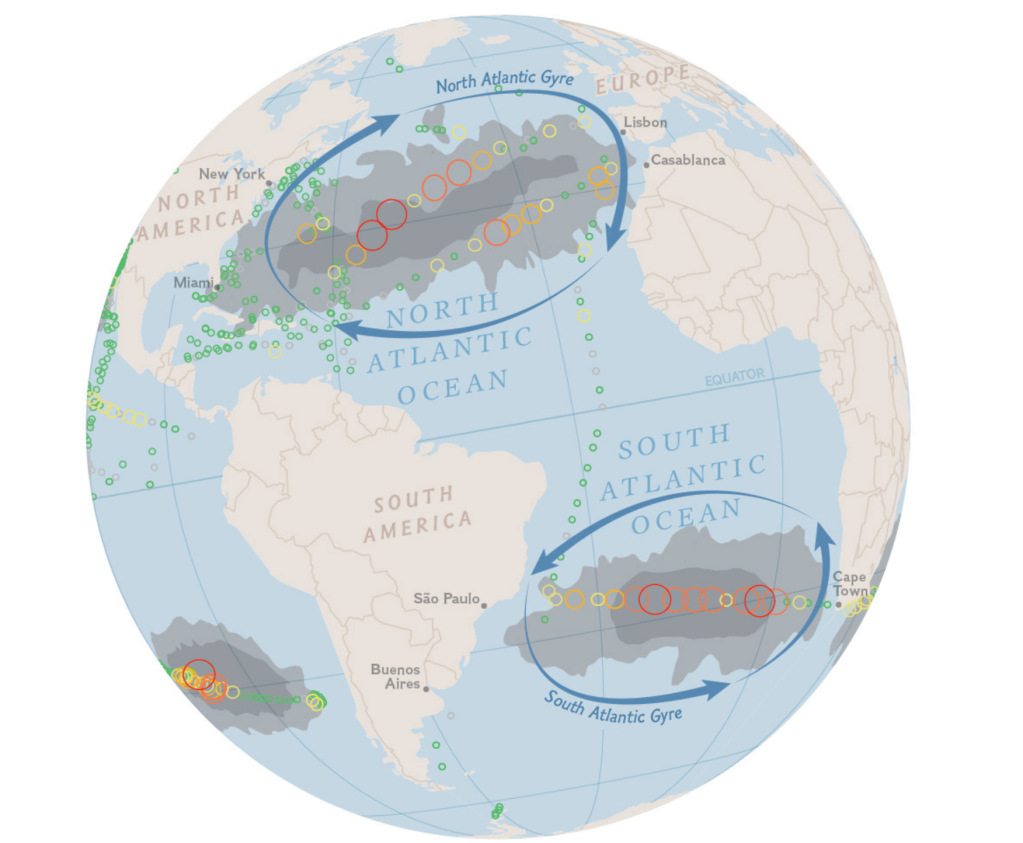

There remains a dangerously deep risk of de-familiarization of the planet due to data overload. These global trends are so cognitively overwhelming, even in an age of globalization, the rising tide of ocean temperatures seem destined to overwhelm, and not only on the coasts and coastal environments. We have trouble trying to sense this change, as temperature anomalies become the tool in trade to represent an extreme overload of heat burdening the world far from the equator by a blanket of unprecedented warmth both off the charts and physically hard for humans to sustain.
Climate Reanalyzer, Climate Change Institute, University of Maine, based on Environmental Prediction Global Forecast
The appearance of “excess heat” that ranged considerably above average for late July, which was literally hotter than most all Julys since Steve Wonder’s nineteenth studio album was released–enormous stretches of six continents were as much as fifteen degrees Fahrenheit warmer. The powerhouse graphic sent a global alert to caution we were in historically unchartered territory.
Climate Reanalyzer, Climate Change Institute, University of Maine, based on Environmental Prediction Global Forecast
The current calculations of heat stress on the human body in direct sunlight–“wet bulb temperature”–is a measure of heat stress, is in a sense the reduction of that temperature change to the basic common denominator of the human body. Although the point-based assessments might map to isotherms, in a broad way, the outliers might be so extreme to render this pointless. And the current water temperatures in western Florida of over 90°F or 32°C in the Keys, three or four degrees greater than land temps.

The land is both inhabited–and we are suffering from overwhelming excess heat. But the record heat absorbed in the global oceans and rather unprecedented effects of rising Ocean Heat Content—-water temperature change times the density of water times its heat capacity–has led the Gulf of Mexico to rise 1.8°F since 1950, and in May 2022 almost two degrees Fahrenheit above the 1981-2010 average, fed by the deep fast-moving warming waters that long intensified the Gulf’s heat. (The red is here denoting the rapidity of the Loop Current that enters the Gulf from the Western Caribbean; the indigo denotes the relatively still waters along the coasts and semi-enclosed sea, shown in a combination of rasters and vectors of warm Loop Current’s sudden influx to the Gulf.)
Ocean Heat Content of Loop Current Entering Gulf of Mexico May 2022/image: Navy Research Lab
The recent alerts that NOAA issued to alert the Florida Keys to the threat of widespread coral bleaching in late July transform the once-bucolic waters off the sleepy southern Florida coast into a dark red danger zone may make coral a surrogate for humans. The rasters that shift attention from the land offer a salutary alert and caution, but their saturated colors are hard to process without alarm.
The recent risks of coral bleaching in the Gulf of Mexico’s waters may be so powerful not only as coral is a keystone species, of broad impact across the ocean ecosystem, whose living reefs offer food sources that promote or foster biodiversity in tropical waters, whose very structures and food sources promote biodiversity, and allow the ocean waters to function as a carbon sink, the image is apocalyptic as a record of the declining vital signs. Are corals a proxy for wildlife from migrating landbirds to a vast and vital coastal ecosystem centered in wetlands, whose habitat and food sources would be threatened to be compromised by petrochemical accidents or potential spills?
The density bird stopovers along regions of the shore and wetlands map an area most vulnerable to maritime spills or pollution. A single spill would compromise a vital stopover habitat mis-mapped as a shoreline, and not a resting and feeding site for birds making returns north after a thousand mile migratory flight to search for food that will equip them to continue their journey north. If the striking density of bird stopovers in the Gulf of Mexico might suggest a value that is erased by the mapping of value in offshore lots leased for excavating oil and gas.

Predicted Avian Biomass in northern Gulf of Mexico per Weather Surveillance Radar Data. uploaded from USGS Distribution of Migratory Landbirds around Gulf of Mexico
The red rasters hemming in Florida’s coast recall the unhappy ending of the father and son who wander across a post-apocalyptic America in that first gothic novel of climate change, The Road, which eerily doubles as the first novel of post-9/11 America. Father and son travel on foot to an ocean whose surface is not at all blue, as promised , but reveals itself in the book’s final pages as a “vast and shifting heavily like a slowly heaving vat of slag,” transformed to a “the endless seascrawl” as if itself rewritten. “I’m sorry it’s not blue, he said,” the father manages, whose son, expectations long diminished, replies “That’s okay.” It is not the coast of Florida, but it might as well be the coast of a massive coral die-off, of dead zones, littered by detritus of nuclear or atomic ash. But this is not the story we want to tell, invoking a leap of faith at a gray, grimy mournful end.
This is one, archetypical, story of climate change, and not the one we want to have. It is a story of love and despair, as grimly post-apocalyptic as one might imagine, if deferring the apocalypse, but only not to tell us how it ends, but to suggest something akin to spiritual if not religious consolation. That is, perhaps, as far as it gets as a story of hope. But the alerts NOAA released seem increasingly of a sea shorn of life, if not yet covered with post-apocalyptic ash, registering an apocalyptic reality that might only find redemption, William Gibson has suggested, in a more recent twist, we might only be spared by by a virtual surrogate alternative reality.

Regional Heat Stress Map for Florida Keys/Coral Reef Watch, NOAA (July 26, 2023)
The threats of the absence of equilibrium in such a map fly directly in the face of an image of hope, as well as the recommendations the International Energy Agency planned as a roadmap to net zero emissions of approving no more new oil or gasfields for development from 2021. Not only the United States have granted far more licenses to fields, many of which are offshore and an increasing number in the Gulf of Mexico–if the Gulf of Mexico became regarded as a “national ocean” from the 1950s, new wells may be slated beyond national waters.
If April is the cruelest month, as the world regenerates, “breeding lilacs out of the dead land,” June is the month of pronouncing on impending anomalies of global melting as lilac drifts to the northern climes. If lilac offers the color for cooling waters, in most ROYBGIV color ramps, each summer, lilac seems to be moving farther and farther to the poles, as the equatorial regions approach 35C, the withdrawing of cold water to the poles is in a sense an occasion of mourning, with Whitman, a sense of loss. Newton may have introduced indigo in the rainbow spectrum–as Thoreau was to give prominence to Cerulean, another tertiary color–to affirm the sacred geometry of the rainbow, after first finding five colors and then adding orange, but its prominence in the Opticks (1704) denotes the rim of warming waters on the blue-violet edges of arctic regions, levels of lilac in the north suggest the scarcity of cold, cresting the arctic regions of water where ice melts. May be the uncanny warmth of indigo has made it into a default of warmer ocean become an omen of warming waters that lead to an unstoppable glacial collapse, not only in the west Antarctic, as indigo seems the apt color of the danger of a feared potential rise of global ocean-level by over a half-meter, and triggering a rise of several meters more–and the fear of an inevitable retraction of the edges of the Antarctican ice shelf of global consequence.
Global Impacts from Shrinking Ice, Visual Capitalist/Research by Niccolo Conte; Design of Mark Belan
And the uncanny warmth of the near-arctic oceans, ever warmer in recent years, as the warming underbelly of floating ice, seem a fearful record of the warming waters set to trigger large and potentially sudden changes in sea-level rise. Even if we are confounded by alarming carmines and deep reds in raster maps of landsea temperature anomalies in recent months, the warming waters of lilac and indigo speak rather deeply to the warming of arctic and sub-arctic waters.

Thwaites Glacier in West Antarctic Ice Sheet/NASA/AP
Does telling a potted but pertinent story about indigo as color offer a surprisingly global tale of markets and man-made world? Indigo has a history, and the history of indigo as a plant dye that entered European luxury markets as a craze for vividly colored clothes in the seventeenth century would boom in the eighteenth, but made it the most noticeable color of note to the English eye when it was included in the spectrum in the Opticks (1705), when it had challenged the longstanding use of woad to color wool. No doubt reflecting the dominance that material versions of blue had secured in the market for colored fabrics before the discovery of Prussian Blue in the early eighteenth century, a precious resource and prime product of harvests in colonial settings in the West Indies used in the textile industry whose importation was already a prized if not dominant import from 1650 in the transatlantic trade from Spanish colonies, “the most famous of all dyes” no longer arrived from India, Newton would have been familiar with the stability of “true indigo” as a universal dyestuff, if one deeply compromised and affected by the War of Spanish Succession, whose purity as a ground vivid color grew in the textile trade–by the late eighteenth century the East India Company exported over a million pounds of the dyestuff from Bombay and Surat as gild restrictions on its importation eliminated or reduced, as Spanish indigo replaced the Indian origin of Indicum, notwithstanding the plant’s historical toponomastic origins. (Recall the blue dresses worn by Vermeer’s women beneath their linen veils in their private, whose vivid Delft blue made us privileged witnesses of global ties of commerce in quotidian interiors of scrubbed walls.)
The global origins of indigo in the transatlantic trade is aptly tied to a first age of globalization, as much as for elevated reasons of mystical harmony or the spectrum of available paints–whose warmth finds new if dissonantly telling prominence in our ocean maps.

The scarcity of indigo from India was challenged as New World imports reshaped luxury textile markets to feed a growing markets for fashionably vivid colors. But the scarcity of indigo in early modern European markets seems apt to illustrate the shrinking margins of cool waters that are driven by anthropogenic climate change, as global markets for energy prospecting oil and gas fields have released greenhouse gasses es into the atmosphere with seemingly irreversible consequences.
Warmer indigo waters create a slippery if critical band of sea surface temperatures above freezing that has encroached the edges of global arctic oceans–the very region that the scientist James Lovelock, father of climate studies, cunningly chose to be the last remaining temperate region of a climate apocalypse, in The Revenge of Gaia (2006), where the flipping of the global climate due to greenhouse gasses and ended animal life has forced polar migration for its few remaining survivors: those compelled to travel to the only cool sites of the Arctic, migrating to the few remaining oases with camels they have presumably fled where temperatures only cool as the sun’s rays dissipate. If Lovelock’s was a clear-eyed cautionary tale about the stresses on the global system humans created, the equatorial heat already spanning oceans in contemporary maps of eighty and ninety degree water have clear red foci of intensely electric carmine in the Persian Gulf and Gulf of Mexico, and off of China’s coastal waters, that have received less attention than the individual buoys that register “record” heat cresting the magical metric of 100°F. The novelistic retelling of the “Gaia” hypothesis viewing the earth as a coherent organism able to be seen as a self-regulating system in 1972 was dramatically disrupted in ways that offer a bracing story of the consequences of a climate out of balance of which indigo may be an apt indicator indeed.


Melting is something foreign to the waters of the Gulf of Mexico, where we were already breaking significant records in Spring. But we are increasingly relying on new carmines as we used new violets last year to register the extreme heat wave that strained power grids in the west in a previous heat dome in September 2022 that colored the Central Valley, Las Vegas and Phoenix shades of violet as a hot air mass settled over wester states for multiple days. We had warning. We suffered the warmest May on record. per the European Union’s Copernicus Climate Change Service; global sea-surface temperatures hit record highs in May and June, as it became clear that this summer was less of a season than a record of extreme heat.
By early July, a heat dome engulfing southern states around the Gulf of Mexico pushed the color ramp to deep reds, and meant triple digit temperatures of excess heat scary heat dome, whose isotherms span the border, in a reminder if we need it that global disruptions do span borders; El Niño stands to create record global July temperatures, as warm weathers off the global oceans wrap themselves around North America, raising lands temperatures upwards of a hundred degrees Fahrenheit in new record temperature anomalies.

Weather Bell/July 10, 2023 Forecast by American GFS model (F)
The rising sea surface anomalies suggested extraordinary temperatures of an intensity we’ve rarely experienced, and are challenging our color ramps moving toward darker and darker carmine. The temperatures around the coast of Florida are not limited to the threatened ecosystem of its Keys, where water temperatures above 100F° in late July lead to wide die-offs of coral reefs.
The isotherms tracking landsea temperatures make it hard to get specific or drill down into amidst the array of alarming datapoints. But the deviations of anomalies of sea surface temperatures are a terrifying hint of what might be in store, the Gulf Stream carrying warmer waters than ever to the Arctic North, warming the Baffin and Labrador Seas, as well as parts of Hudson Bay–show lowlands. These regions are already among the fastest warming in the planet–projected to warm at a rate three times higher than the global average, sending fewer cooling winds across Canada and offering less of an amenable subarctic habitat for whales or polar bears.

Sea Surface Temperature Anomaly (Centigrade), June 14, 2023
If June is the month to register the first anomalies of summer months, July has become the time of realizing extreme warming is going off the charts. These temperature records are anomalies we had not imagined, and stretching beyond color ramps with which we are familiar. And they are being circulated with far more alarm than the sense of inescapability already present as the 1980s presented the hottest decade on record–including five of the warmest years since 1890. If the arming of arctic permafrost was first detected in the 1950s–as dozens of exploratory oil wells were drilled in Alaska’s North Slope, the inevitability of global warming was tied to the fears greenhouse gas emissions would bring an exponential growth of CO2 levels in the global atmosphere, forecast to reach the benchmark threshold of a doubling of preindustrial standards by 2030 in the early 1980s, if no reduction of emissions were taken, and the earth entering a path toward irreversible warming of 2 to 5°C by 2020 and a doubling of carbon dioxide levels in the global atmosphere.
If the optimistic hope was to slow warming and carbon doubling until 2060, worries of coastal flooding and erosion–or of land erosion in places like the Gulf of Mexico leading to ocean flooding–the dangers of sea-level rise that is primarily due to fossil fuel combustion–as well as deforestation–has been replaced by even more anxiety-producing stories of the warming of ocean heat and its effects.
The focus of rising sea surface temperatures have striking continental focus in the waters of the Gulf of Mexico–characterized by a surface temperature anomalies from the 1950s, partly due to the low level of the ocean from the seafloor, rising by the mid-1970s and by 1990 at extraordinary rates.

Time Series Chart of Average Sea Surface Temperatures at Ocean Surface and Ten Meters in Gulf of Mexico
We are hard pressed in the middle of July to realize how sea surface temperatures are poised to escalate with El Nino. But they are so deeply red in places like the Persian Gulf, that global site of oil production, and in the site in our own national waters touted for possible future oil extraction–the Gulf of Mexico. These are among the most anthropogenic areas of the world, made for intense offshore petroleum extraction, where oil seepage and spillage may create a uniquely elevated ability to capture heat in their swirling current coursing in its semi-enclosed ocean waters.
Lilac hues signifying colder global waters are pressed to the Arctic and Antarctic, at the boundaries of or outside the bounds of human settlement. And lilac is a scary reminder that few colder water will be sent southward in the Meridional Overturning Circulation that sends colder, saltier water across global oceans that drives marine upwelling. But if this is the global, the story is in many ways local, too, as the changes in the heat of the Gulf’s surface waters, even before El Niño and La Niña, are warming those gulf waters as astounding rates as they swirl in that semi-enclosed sea-


Climate Reanalyzer, Global Sea Surface Temperatures/July 22, 2023
–and by the end of the month, just four days later, Sea Temperature was introducing lilac in its ramp for global oceans, in an extraordinary expanse, and rightly so, to register the rising ocean temperatures at the equatorial belt as a cause for alarm. Lilac is the only way to communicate these extremes, perhaps, to catch one’s eye, as perhaps Newton knew it would have, as it was feature in any rainbow, but as Newton must have known indigo well from the common use in early modern England of imported indigo dyes–indigo discharge printing of saturated colors long before William Morris prints, in indigo chintz–that were so popular that by 1720 the Calico Act restricted global trade of calicoes and indigo dyes to appease wool gilds who used woad plants, assessing fines for “Use and Warings in Apparel of imported chintz, and also its use or Wear in or about any Bed, Chair, Cushion or other Household furniture”–true indigo gained status to catch or arrest the eye, as indigo or lilac in our maps of current sea surface temperatures. The weaker dye from European woad–the isatin tinctoria of colder climes–was never as vibrant as the imported indigofer tincotria. Before restriction of the luxury import, Newton would have known the treasured dyestuff of “truer” imported indigo: the luxury trade of woad ensured Languedoc’s wealth in 1705 as “the richest in Europe,” but indigo displaced woad’s currency as a guarantor of credit was displaced by indigo, as it displaced the chromatic organization of dyers gilds–red, white, and yellow; green, black, and blue–derived from Aristotelian: indigo’s intensity was implicitly modern in Newton’s rainbow spectrum, unlike blue.
But indigo and lilac haunt the color ramps of sea surface temperatures as extremes, at the arctic edges and the equatorial zones, at the super-hot and indigo waters at the poles formerly freezing “warming hotspots” of the north.

World Water and Global Sea Temperatures, www.seatemperature.org/July 26, 2023
We may have to live with more indigo–just above freezing, where surface water shifts to marine blue–in the rasters of our maps of sea or sea surface temperatures, and try to tell the clearest story possible. This should be a story that is far more explicitly anthropogenic in nature, but a story few maps tell. To do so would be to remind us of the materiality for these changes, and indeed the materiality of Newton’s inclusion of indigo in the rainbow spectra on which our color ramps and buckets rely. The deep reds of those isotherms–whose reds seem so much heavier, impinging itself on the global ocean, no longer bridges land and sea in a topography of heat, given problems of translating land heat to the heat of the surface, force us to contemplate the anthropogenic effects on ocean environments. Whereas Romantic art promised a merging of the human with the natural as an ideal, subsuming the natural to art, the art of mapping anthropogenic influences on nature is central to the intensifying problem of mapping our current relation to our climate emergency.
We might well return to the global synoptic maps of ocean warming, enhanced by appreciation of local detail that are the best ways of gaining access to their meaning and cascading effects. The rapid rise in sea surface temp was not a record, although its surface temperatures had been rapidly rising, but hovered around the 80°F threshold. While the nightly news graphics seek to command attention as an immediate existential threat, however, the deep causes of the surrounding seas’ growing temperatures and the challenge that they pose for oceans’ memory demand greater attention and appreciation for the long-term changes in governance that have gotten us here–the transformation of the Gulf of Mexico to a sort of open bank account of perpetual national oil reserves, able to be claimed by seabed rights, that seep to the ocean, pumping of groundwater to feed crops and cities, phosphorous flows to the coastal ocean and into the sea, deluded by what may well be illusory hopes to inject waste into wells that themselves seep offshore.
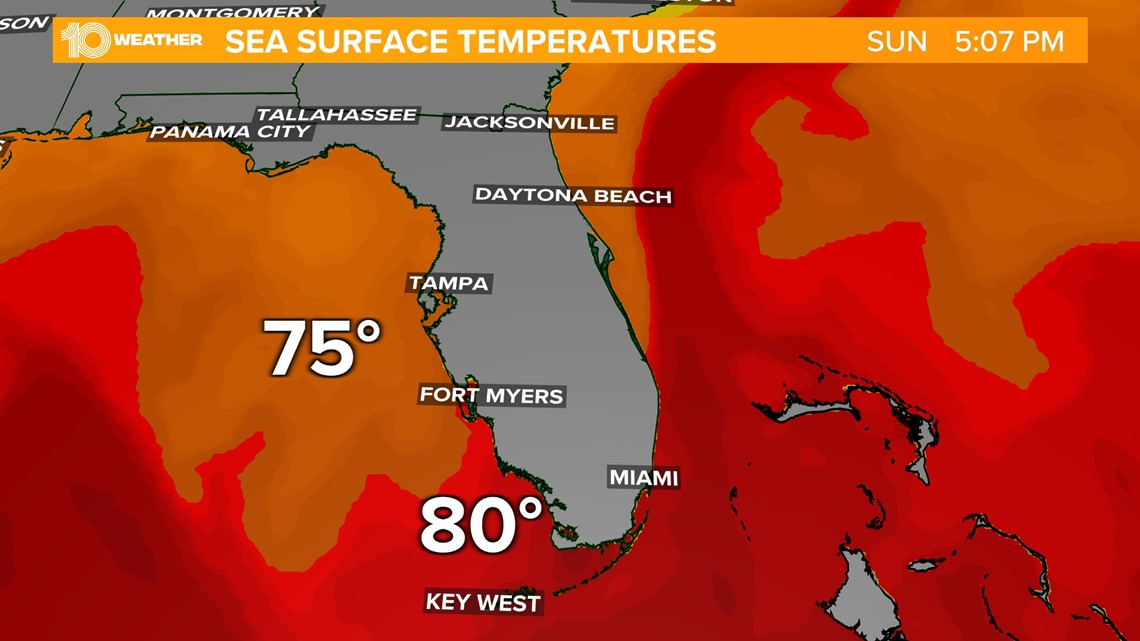
The danger signs of red, the sign of danger flags, red alerts, and blood, have been intensifying in the color ramps of overlays that we place on ocean currents in the maps of sea surface temperatures for several years. Yet rather than see the oceans as passive victims of climate change, the maps we make might seek to register or appreciate the active anthropogenic nature of those changes in sites like the Gulf of Mexico and the western and eastern Florida shores. Terrifying climate records had been announced nationwide, of course, by mid-June, before catastrophic rainfall hit New York and Vermont, with accumulated humidity condensing in the air, as anomalies of notable escalation hit the climate community from the first days of June 2023–following the warmest May on record, of a new high by quite a margin, as Antarctic sea ice suddenly shrunk to record lows, setting off alarm bells about global sea surface temperatures that haven’t been able to be silenced.
The outrageous color ramps of astounding rises in sea surface temperatures register a remarkable change in coastal waters, as global oceans hit record highs, with the ocean temperature rising as oceans absorbed the lion’s share of excess anthropogenic energies and a pronounced warming of the North Atlantic Ocean and the Gulf Stream that has sent warming waters to the North Atlantic, in a spectrum of red and blue that suggest the end of the cooling waters of the Arctic Ocean–as well as a global picture of climate change, if we needed one, rooted in the anomaly of sea surface temps across the globe. But as we wonder how those changes will be relate to local government–or how mjuch they outstrip the ability of any local government to respond–the crisis must be seen as one of governmentality, as much as climate.

In posting the deep lavenders off the chart temperatures that surrounded the coast of Florida this early summer, he Newspaper of Record shifted our attention to the corals, and the danger of their bleaching, beyond indulge in the effects on humans alone of these rising temperatures alone: they weren’t inviting us to take the “animal turn,” but turning attention to how the surprising spectrum was not only about when it was good to swim, but concretized the warming as a living record of marine health, akin to a charismatic keystone species. The warming is rarely tied explicitly to government, but an early engraved map of Florida might hint at the difficulty of mapping clear boundaries of land and sea–a Google maps artifact, but also one of mapping softwares–not because of its greater accuracies or inaccuracies, but the complex relations between land and sea that are suggested around the Gulf of Florida, both in the land-sea fracturing that defined the ‘state’ and its government, and the dotted lines of those far less sharply defined shores.
As K. brevis sends unprecedentedly ballooning neurotoxins s into the Gulf of Mexico and to Florida’s Gulf Coast waters, yet again, and blows onshore to trigger lung symptoms for many, as it enters the air, we are reminded of how much land and sea are tied, in the rusty red tide lasting for months off of Florida’s western coast washes a shore, we might ask about the porous nature of good government in Florida, both East and West alike, by looking at the appreciation of this porous boundary of the shore that was central to early maps of the region–not only before landfill led to the remaking of the state, but before we were convinced of a firm separation of land and sea.
Sailors of course paid more attention not only to the existance of islands in the Gulf of Mexico, where their crafts would run ashore, but to the great sand banks as the Great Bank of the Bahama (or Great Bahama Bank) that is one of the largest of the world’s fringing reefs, even in an era of routine sand pillaging and illegal sand mining. But as our shores have become too narrowly defined, as we have viewed them as the edges of government. As we imagine the shores overly sharply defined, the irony may be, unregulated drainage of sewage, industrial fertilizer, and urban wastewater create decisively warming temps around that quite critical coastal margin, where warming temperatures enter into that purple, reminding us yet again, in way, howe much anthropogenically caused heat oceans are trying to absorb–and how off the charts the rises in temperatures are to the ocean’s memory. The presence of and threatens to ocean memory might well be part of the stories that we tell about climate change, and indeed made central to them.
Indeed, rather than see the ocean as a glassy surface, as if the surface temperature were a record of the sea surface, suspended by an illusion of calm waters, we need maps that allow us to look deeper in maps, to the areas underneath, as this post has tried, and noting what else is on the surface of the seas as they circulate ever-warmer waters off sensitive coastal environments. So much is suggested by the coral reefs, dotted zones in danger of being bleached at higher temperatures. Rebecca Solnit invites we entertain the climate crisis as “in part a storytelling crisis,” a crisis in which we find ourselves “hemmed in by stories that prevent us from seeing, or believing in, or acting on the possibilities for change.” The foreclosure of possibilities are perhaps nowhere as evident in the finality of the color ramps of maps of global climate that trigger our alarm; color ramps of sea surface temperatures are, in their opacities, perhaps as much as fault as being part of that problem. They are an ultimatum, as much as any thing like a narrative, as much as a late-arriving warning sign and a cry for help: the stark disequilibria of something so large as a global climate or “surface temperature” is hard to grasp with anything like traction, let alone weave a story around.
Yet the problem of mapping a story of where we are requires more depth, and detail, of appreciation and perhaps wonder, as much as fear. As much as posing existential issues of impending ruptures in ocean habitat and even in ocean memory, we might pay better attention to the local scales of what is lost. For the inattention to the changes that are already quite evident in the membranes of coasts and the margins of shores, stories that don’t leave us much room to move. They are multiply depressing stories about about politics, or governance, and the irresponsible expansion of seabed governance to mine and extract non-renewable energy sources as petroleum and natural gas, to supply petrochemical needs. Yet the stories that we tell are perhaps so depressing as they ignore and are rarely addressing shores as lived environments or enduring habitat but the steep fears and constraints of coastal risk and of both urgency and emergency.
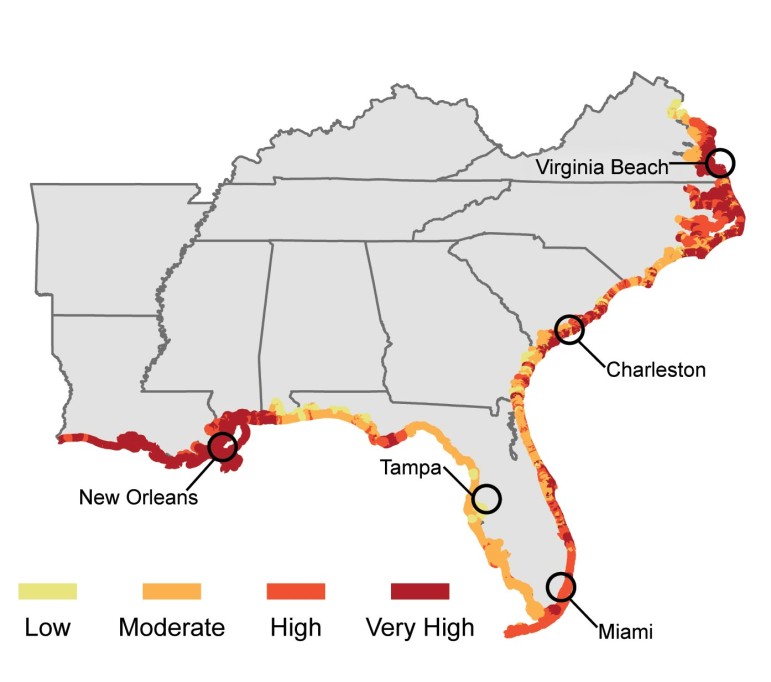
We are perhaps far, far beyond investigation, regulation, rehabilitation, or clean up of isolated sites contaminated by the spills and discharges. But we must look deeper into the maps, perhaps beneath the frustrating opacities of crimson and the misleadingly gentle lavender. Hui Shi of the Farallon Institute in Petaluma, CA suggests that similarity in ocean surface temperature from one year to the next is the best “simple metric for ocean memory,” independently from atmosphere-ocean exchanges, as a systemic change in ecological memory. Another way to see this, of course, is by remembering the long permeable membrane of Florida shores, an implicit part of its good government, and one that has been neglected in the erasure of banks, reefs, and undersea health that is long part of the region, and erased by the reduction of the region’s “government” to the policies of one state–and to call more attention to the role of good government in the very porous relation of land and sea in Florida’s government, that appreciates the state’s integral connection to the Gulf of Mexico as well as the “Gulf of Florida” and Atlantic Ocean.
We map the sea-surface temperatures around Florida by a color ramp, as if they were similar or about the same as land temperatures. they are not. Not only does the ocean absorb a huge amount of anthropogenically driven climate change. The disruptive nature of marine heat-waves are less similar to those on land, as they can be more intense, and more sudden, and even more directly impacting human health and disrupting abilities of meteorological assessment and prediction, and compromising our relation to the shores. If ocean warming accounts for some 63% of the stored heat of the planet, rising temperatures of expanding oceans threaten coastal communities, and undermine the very clear lines we drawn in most of our maps–including weather maps–that fix edges between land and sea as distinct divides. They are not, and this is a casualty, perhaps, of the graphic syntax of the map, which signals a divide, rather than a membrane or, better yet, medium.
The oceanic amnesia between rapid sea-surface temperature changes can be mapped, scientists have argued, in a neat cognate of a sea-surface temperature map, in terms of increasing amnesia–a sort of memory-decline on a global scale–that is jarring because of the choice of blue as a metric of declining memory, and a decline in the continuity between temperatures between one day and the other, that is not only in the water of the ocean, but also its habitat and ecological stability and vitality–the very problem of the coral reefs that are the focus of the Times article. The discontinuities of sea-surface temperatures suggest a major disrupter, in other words, tied to different scenarios of climate emissions, reflecting decreased thermal inertia of the uppermost layer of the ocean, as it grows shallower in response to anthropogenic warming.
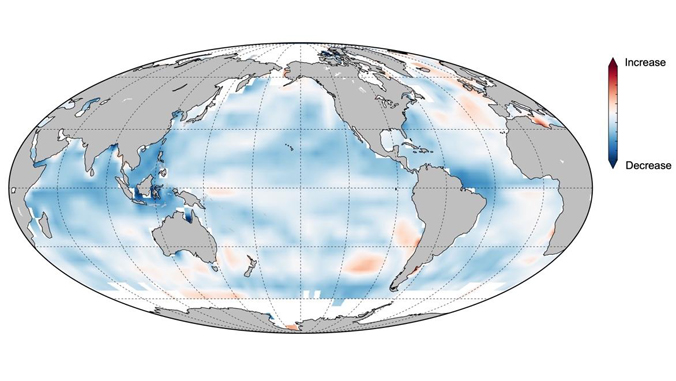
She, et al., Science Advances (2022)
She’s metric for “ocean memory” is perhaps a far better and significant chart than the existential immediate sea surface temps, and demands to be placed in a sense of temporal duration, tied to the degree of ocean memory that seems to have existed in the last century, and over different possible emissions scenarios, for the coming decades. He suggests a need for attention to the management of marine ecosystems–which we regard in a largely quite laissez-faire manner–and expansion of government from land-based regions to oceanic environments, and to those sensitive margins of land and sea–watersheds, swamps, tide pools, shores–where life is increasingly abundant, but are also increasingly determinant of biotic and environmental health, in ways that makes them health multipliers. If clever folk at the island-centric UH Mānoa have documented the increased ocean heat anomalies from 1993 to 2019 in the upper layers of oceans, those very sensitive registers of ocean memory, of seven hundred meters in depth, the warming of 53% of global oceans suggests a decline in memory, of some significance, with but 3% of global oceans able to be characterized by cooling trends. From 1968 to 2019, whereas ocean warming was found in 72-9% of global oceans, cooling confined to but 1-2%, in a terrifying trend that only mirrors the dangers of the scale of such a massive memory loss.
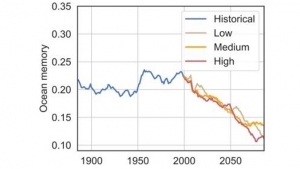
If speculative in nature, the historical depth of a discussion of long-term ocean memory suggests something quite distinct from the structural sort of histoire immobile as is fitting the ocean sea: rather than rooted in economic arrangements that we can map by structures, the slipping away of ocean memory suggests a receding shoreline, or a failed ability to grasp the sudden changes of weather that increasingly characterizes the sea, an erosion, in other words, of a measure critical to ocean health not rooted in the day-to-day nature of surface temperatures, or the disputed averages of temperature over time, but of the ability to navigate the coming sharp changes in ocean health, which, with a majority of humans living on or near the shores, we should be compelled to attend. We risk, as my late friend John Gillis reminded us often in his final years, “turning our back on the shore,” imagining the healh of the oceans to exist independnetly of the land, and the ocean able to be mapped as an extension of the topography and heat of the land.
Another way of seeing this absence of continuity of temperatures might be in terms of the setting tight the oceans offer: the predictability of the warmers as hospitable environments, in other words, rather than as sites of escalating temperatures approaching trigger points for the massive die-offs we have seen. To be sure, surface temperatures are not only reason for die-offs. But they are at play in them, and probably more than we realize: the failure of oceanic environments to be hospitable environments are not only able to be measured by individual digits of Centigrade and Fahrenheit, but, as oceans are absorbing ever greater surface temperatures, of ecosystems most affected by solar irradiation, the rise of sea surface temperatures in the Gulf of Mexico between 1970 and 2020 stands out–warming at twice the rate of the upper layer of global oceans, as ocean heat content in the region has risen so dramatically to raise questions about environmental ocean management–and to explore reasons for the imbalances in Ocean Heat Content (OHT) globally in relation to anthropogenic activity in the upper 700 meters of the ocean, that can help track marine heatwaves that have become greatly more prevalent in the past century.
And the Gulf of Mexico–which receives runoff from over a hundred and fifty rivers from thirty-one out of fifty states, is a sort of distillation of the polluted content of our American rives, in ways that riverwater from more than 150 rivers and runoff from 31 of the 50 states, including nitrogen and phosphates, as well as offshore petroleum-producing zones, a main cause for hypoxic zones and harmful algal blooms, is notably warming at twice the rate of the world’s oceans.

If coastal Florida had seen a distinct rise of temperatures in the heat content of offshore waters, a huge stress on marine environments, in the 1990s and early twentieth century, the recent escalation of heat waves across the Atlantic and Gulf Stream suggest a real reason for panic, tied to displacing habitat, and less salty–and less dense–ocean waters, that are especially dangerous to the vitality of oceanic environments–and the danger of die-offs, often not mapped by digits alone. Far better to focus on and scrutinize trends, disturbances, and abrupt shocks to the ocean’s environment, and to the mitigation of those shocks issuing from the land, and interface of land and sea, where toxins and industrial discharge and pesticide runoff leaches offshore freely. Even a relatively circumscribed “deep view” of warming trends from, as it happens, the start of the Trump era, reminds us, by its dark red blotches, of the warming waters off of American coasts, warmed by the Gulf Stream that carried Caribbean waters from the Gulf of Mexico along the eastern seaboard.














